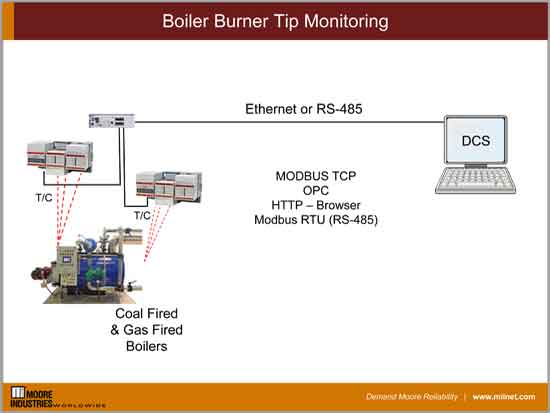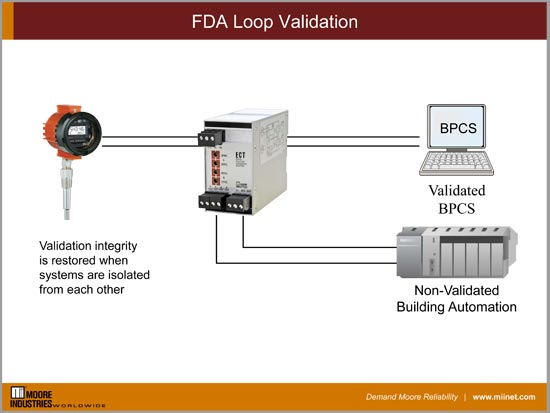Learn how distributed I/O products provide a universal and modular way to connect a wide range of signal input and control output possibilities with this informative video. Industry expert Peter Welander shows how the NCS NET Concentrator System® saves time and expenses associated with the installation and repair of wiring.
Watch the STA Safety Trip Alarm demo to see how it is an economical and easy-to-use way to monitor critical process signals and alert personnel to problems. Journalist and industry expert Peter Welander demonstrates the ability of the STA to monitor the temperature of water in a "hot pot" and trigger an alarm if it goes outside of a pre-programmed range.
Watch and learn how a flexible temperature sensor can ease installation and save costs! This Temperature Sensor technology demo featuring industry analyst Peter Welander highlights the advantages of flexible Thermocouple and RTD sensors. It focuses on the WORM Flexible Temperature Sensor from Moore Industries, which provides a universal sensor strategy that will save you time and money.
Wireless I/O systems are gaining in popularity as plant operators understand the benefits of costs, reliability and flexibility associated with switching from traditional wiring. In this video, journalist and industry expert Peter Welander shows how the WNM Wireless Network Module from Moore Industries provides a robust and versatile wireless I/O solution.
Natural gas and oil production involves the use of monitoring and control instrumentation with continuous gas needs. This is challenging for sites in remote locations with limited power resources. In this video, Moore Industries looks at one real-world example solved by our HCS HART® Concentrator System.
A short circuit or break in a FOUNDATION Fieldbus segment can lead to production shutdowns. But until recently, creating a fault-tolerant, redundant Fieldbus solution has been costly and time-consuming. The TRUNKSAFE Fault-Tolerant Fieldbus System from MooreHawke is an affordable and effective solution.
Moore Industries is always thinking about solving real world problems customers commonly face. In addition to providing world class instruments, we often get requests from customers about mechanical mounting challenges and retrofit situations. Once again we have come up with a quick and convenient solution for cabinet and field installations. It is called the G-Type DIN-rail Adapter. This clever solution allows any Top Hat 35mm DIN-rail instrument to be immediately installed on existing G-Type 32mm DIN-rail.
Take a brief tour of Moore Industries’ North Hills, California, corporate headquarters and manufacturing facility - one of the last independent, privately owned instrument companies left in North America.
Since 1968, Moore Industries has been proudly serving process manufacturing businesses and fortune 500 companies in oil, gas, mining, chemical, power generation, water/wastewater treatment, pharmaceutical, food, beverage, consumer packaged goods, semiconductor, and biotechnology industries.
Instead of purchasing separate intrinsically-safe (IS) barriers when you need to connect devices and sensors from Class I Div 1 and Zone 0/1 hazardous areas to safe areas, you can connect directly to Moore Industries instruments that include built-in IS barrier technology, reducing costs. Watch to learn more about Moore Industries’ STZ, THZ3, and SPA2IS which feature our unique built-in IS barrier.
The Problem
In this application the gas company installed a RTU & Instrumentation for billing purposes to meter the gas sold to a large steel mill. The user installed their own Instrumentation at the same location (gas gate) and needs to compare the readings.

The Solution
The signals from the user installed instrumentation is collected and sent back to the customer's HMI system using Moore Industries' NCS, NET Concentrator System Process Control and Distributed I/O. This was installed in a local junction box in close proximity to existing field instruments. The NCS is acting as a MODBUS master to the gas company's RTU while simultaneously collecting the signals from the end-users instrumentation (Pressure, DP, Temperature Tx’s).
The data arrives at the end-user's DCS and HMI over MODBUS TCP. The OPC* Server was able to utilize the MODBUS/TCP link to the NCS in order to efficiently share the metering signals with the HMI.
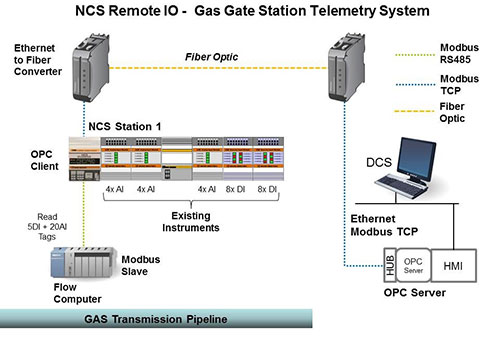
*OPC stands for OLE for Process Control. It is a platform independent open standard that supports the exchange of data between industrial hardware and host systems (OPC Foundation, 2018).
Do you want more information? Download the data sheet. Or visit the catalog.
Need to get price or availability or have a technical question? Send us a message using E-Help.
Q. We would like to use the ECA-DIN in a seismic application. In a worst case scenario of an earthquake, the ECA-DIN must retain its position. We are concerned about the robustness of DIN rail mounting. Is the ECA available with a bolt down option?
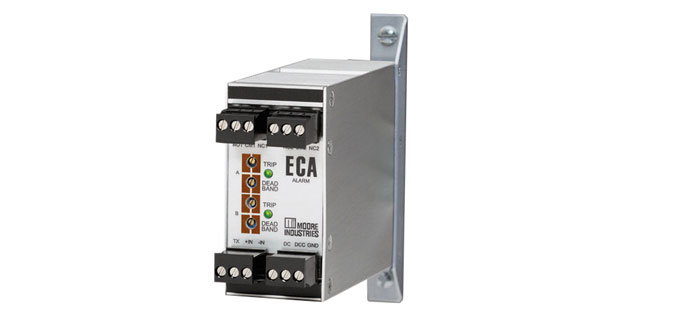
A. We can supply the ECA with side flanges for more robust gearplate mounting instead of the usual DIN rail mounting.
Do you want more information? Download the data sheet. Or visit the catalog.
Need to get price or availability or have a technical question?
Send us a message using E-Help.
A customer in Australia recently reported that one of Moore Industries' early products had been in use for well over 25 years, an EC-DCA Economy Direct Current Alarm (4-Wire). Moore Industries was proud to hear the product had been in constant service for so many years.
Figure 1. EC-DCA After 25 Years Of Service
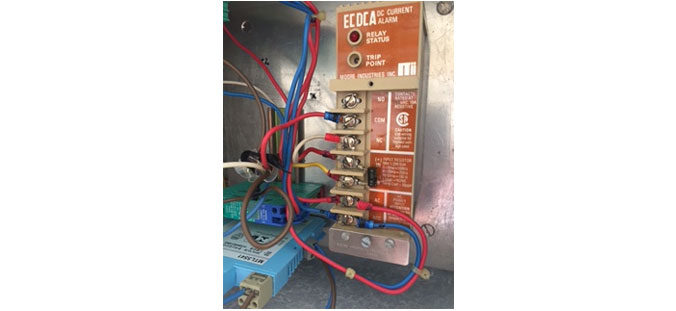
As part of Moore Industries' award winning line of products, the EC-DCA is one of the earliest products manufactured at the company. Although replaced by newer more advanced product designs such as the SPA2 Programmable Alarm Trip, the EC-DCA was a flagship product that demonstrated proven reliability and affordability with multiple input ranges, ease of adjustment by the user, AC or DC power input, and LED relay alarm status indicator, which was cutting edge in the early 70's.
Since many of the products developed are still in use, many of the manuals are kept online for users. If you'd like to see the manual, check it out online.
Do you want more information? Download the data sheet. Or visit the catalog.
Need to get price or availability or have a technical question?
Send us a message using E-Help.
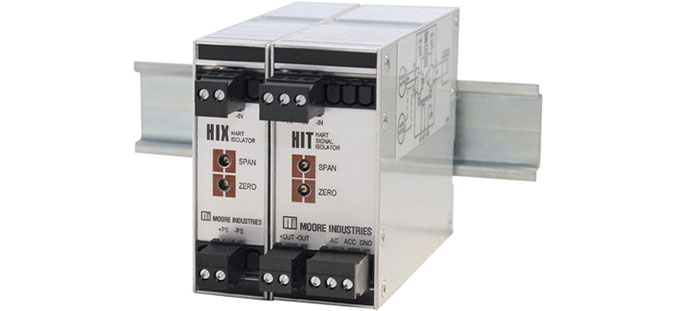
Moore Industries’ HART® Isolators provide highly economical solutions to common and costly problems that plague many of today’s “smart” process loops. Protect and enhance your HART investment with the 2-wire (loop powered) HIX or the 4-wire (line-mains powered) HIT.
Safely share the HART output of one transmitter with a secondary control or recording device. This allows for redundancy without further burden on or risk to a process loop. Protection from surges, spikes and transients of up to 1500Vrms safeguards I/O cards. Add the isolating capability of a HART Isolator to a loop to break the common galvanic path that can pass dangerous overloads from DCS to transmitter to PLC or vice-versa– even when the equipment is supposedly “isolated” already.
Do you want more information? Download the data sheet. Or see all of our HART Isolators in the catalog.
Need to get price or availability or have a technical question?
Send us a message using E-Help.
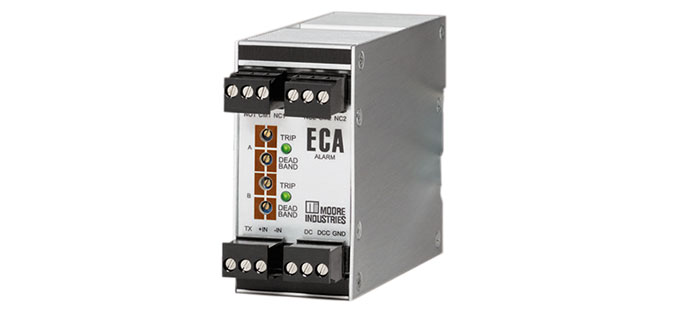
The ECA DIN-style Alarm features a solid metal housing that stands up to the continual rigors of process control and factory automation applications. Rugged and reliable, the 4-wire (line-powered) ECA is the low-cost solution when alarm trip outputs are needed to indicate high or low process conditions. Available models accept current and voltage input from field transmitters, transducers, and other process instruments. When the input falls outside of a pre-set limit (user configurable), the ECA provides contact closure outputs. These are ideal for indicating a high and/or low condition via a bell, buzzer, light or other device.
It features:
- Independently configurable dual alarms
- Wide range of input options
- RFI/EMI Protection
- Fully-adjustable trip point
- LED provides alarm indication
Visit the ECA-DIN in the catalog.
Do you want more information? Download the data sheet. Or visit the catalog.
Need to get price or availability or have a technical question?
Send us a message using E-Help.
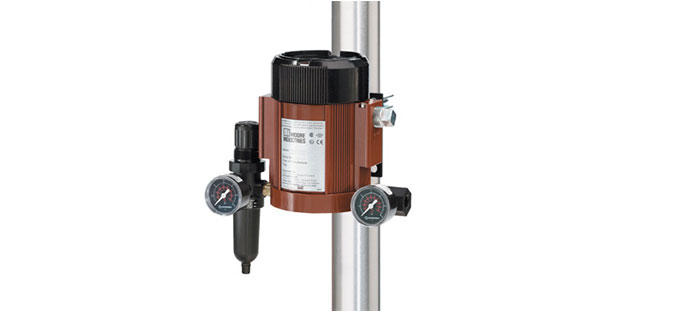
These 2-wire (loop-powered) I/P transmitters accept a current signal (such as 4-20mA) from a DCS, PLC or PC-based control system. They convert the current signal to a pneumatic signal (3-15psig, 0.2-1bar, 20-100kPa, etc.) to provide precise, proportional control of valves, actuators and other pneumatically controlled devices. The economical IPH2 (Type 4X) is watertight, dust-protected, and resistant to corrosion and chemicals. In addition to meeting Type 3X/4X requirements, the IPX2 can be installed in explosion proof environments. Both units are available with an optional coalescing filter/regulator that combines an air filter and miniature supply line regulator with a pressure gauge that reads in both psig and bars.
Features include:
- Wide variety of input and output choices
- Low air consumption and high output volume - output as much as 300SCFH and consume as little as 0.08SCFM
- Accurate and stable - exceptional ±0.25% of span accuracy and six-month stability, they are ideal for precise applications in difficult to access locations
- Immune to supply pressure variation
- Clog Resistant Filtered Nozzle and Orifice
- Removable electronics module
- RFI/EMI protection
Visit the IPX2-IPH2 product pages.
Do you want more information? Download the data sheet. Or visit the catalog.
Need to get price or availability or have a technical question?
Send us a message using E-Help.
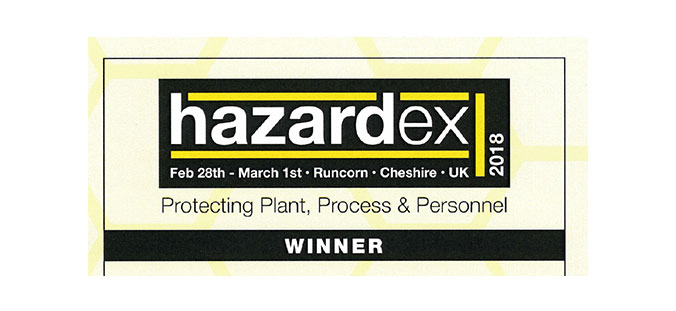
On February 28, 2018 the Hazardex International Conference and Exhibition announcedthat Moore Industries was awarded the Event Delegate Award and was a Runner Up in the Contribution to Safety Category for the STZ Functional Safety Dual-Input Smart HART Temperature Transmitter. Contribution to Safety category recognizes a product, system or service which has made a significant contribution to safety in hazardous area environments. The special Delegates Award was voted on by attendees at the 2018 Hazardex event and announced at the Gala Dinner.
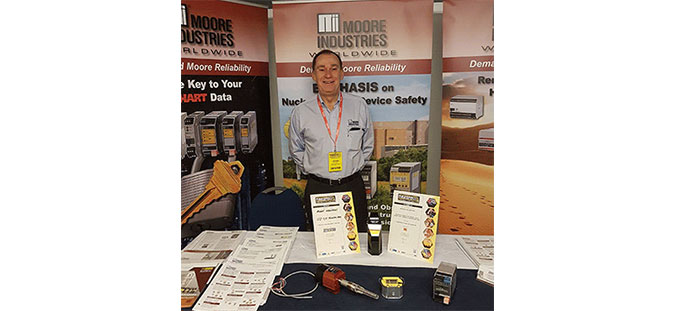
The 2018 Hazardex International Conference and Exhibition took place at the Holiday Inn Hotel in Runcorn, Cheshire, UK on February 28 and March 1. Hazardex is a magazine and online site dedicated to providing information on key aspects of legislation, certification, and products for industrial locations that are judged to carry the risk of explosion.
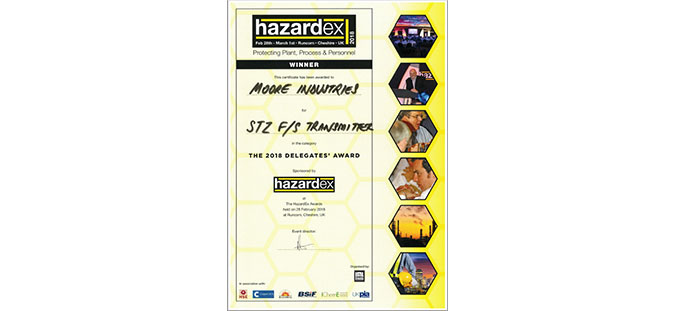
Part of Moore Industries’ FS Functional Safety Series, the SIL 2 and SIL 3 capable STZ Functional Safety Dual Input Smart HART® Temperature Transmitters for your SIS (Safety Instrumented System) configures quickly and easily to accept a single or dual input from a wide array of sensors and analog devices located in hazardous and non-hazardous area.

Moore Industries’ SIY PC-Programmable Signal Isolator/Converter combines smart digital technology with an advanced analog operation to deliver superior reliability, accuracy, and ease of use. The highly versatile SIY accepts a wide range of current or voltage inputs. It outputs an isolated, proportional, 4-20mA signal. As a flexible analog/digital hybrid, this 2-wire (loop-powered) transmitter programs in seconds to handle a wide range of important signal interface applications.
Features include:
- Wide range of signal input choices
- Input/output opto isolation - Superior protection against the harmful effects of ground loops and other plant “noise”
- Fast measurement cycle
- RFI/EMI protection
- Enhanced configuration software
Do you want more information? Download the data sheet. Or visit the catalog.
Need to get price or availability or have a technical question?
Send us a message using E-Help.
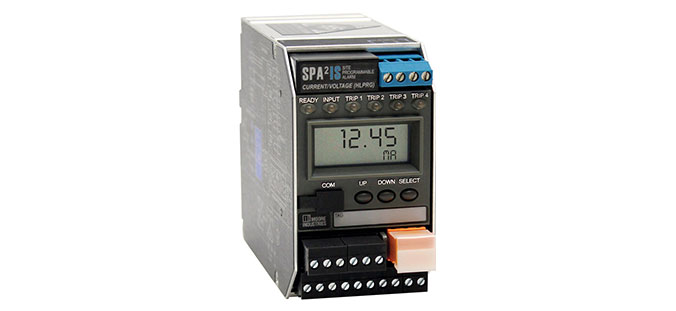
The universal SPA2IS Programmable Limit Alarm Trips provide on/off control, warn of unwanted process conditions, alarm on rate-of-change and provide emergency shutdown. Very versatile, they accept signal inputs from transmitters and temperature sensors that are located in hazardous areas where the method of protection implemented by the plant or facility is Intrinsic Safety. Normally such installations would require the additional use of an intrinsically-safe barrier. The SPA2IS includes intrinsically-safe field connections which provide the necessary protection typically afforded by a galvanically isolated intrinsically-safe barrier.
Do you want more information? Download the data sheet. Or visit the catalog.
Need to get price or availability or have a technical question?
Send us a message using E-Help.

Moore Industries is proud to announce that our ISO 9001:2008 quality management system has been audited and recertified to the latest ISO 9001:2015 version. Our certification is verified evidence that every aspect of our company, from product conception to after sale support, is part of a carefully planned and implemented quality system.
For 50 years, Moore Industries has designed innovations the process industry needs. Since our start in 1968, our continued success is a direct result of listening to your needs, and then providing practical interface solutions.
A sample of our industry-first achievements include:
- Three-way input/output/power isolation as a standard feature to protect against ground loop noise
- Loop-powered hockey-puck designs for safe and simple installation in the field
- Digital cable concentrating/multiplexing technology reduces cost of sending multiple signals long distances
- Total Sensor Diagnostics - patented temperature sensor troubleshooting advantage to save time and money
- Standard high-density DIN-style rail-mount housings
- Unique RFI/EMI protection
- Flexible WORM temperature sensors that quickly install in a thermowell assembly without having to remove the transmitter enclosure or assembly components to save time and money
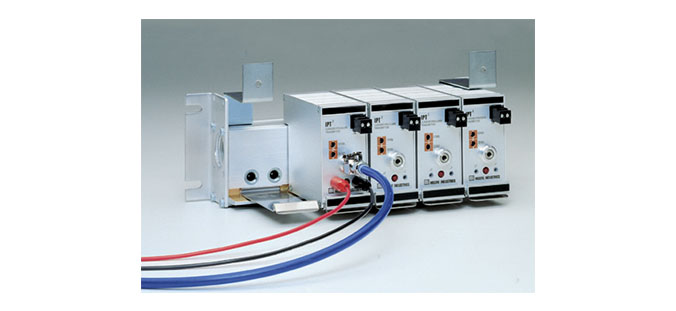
The high-performance IPT2 Current-to-Pressure (I/P) Transmitter converts a current signal to a pneumatic signal so that an electronic-based system such as a DCS, PLC, or PC can control a pneumatic actuator, valve, or damper drive. Available models accept a wide range of current inputs (4-20mA, 4-12mA, and 12-20mA) and provide a proportional pneumatic signal (3-15psig, 0.2-1 Bar, 20-100kPA, etc.).
Features include:
- Wide variety of output and air supply choices
- Low air consumption and high output volume
- High accuracy of ±0.25% of span and a six-month stability rating
- Immune to supply pressure variation
- Clog-resistant design
- Clean start-up
- RFI/EMI protection
The IPT2 is available in a compact, 40mm wide aluminum housing that can be conveniently snapped onto a standard mounting rail or Moore Industries pneumatic header rack. Standard features that raise the IPT2 above the competition include a front panel LED that varies in intensity to reflect the strength of the input current and a built-in orifice cleaning mechanism that eliminates potentially messy clogs. Time-saving equipment such as a pneumatic test jack that simplifies calibration and maintenance is also available.
Do you want more information? Download the data sheet. Or visit the catalog.
Need to get price or availability or have a technical question?
Send us a message using E-Help.
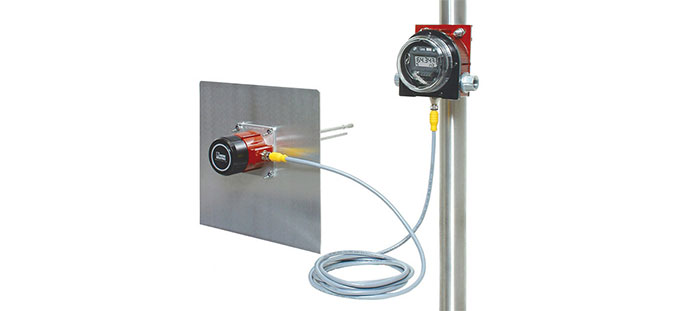
The HTZ Smart HART® Transmitter simultaneously measures humidity and temperature in industrial, commercial, manufacturing, and HVAC applications. Based on the humidity and temperature values, the HTZ also provides a dew point measurement as a calculated variable. The 2-wire (loop-powered) HTZ features dual isolated and scaleable 4-20mA outputs proportional to two of the following (user-selectable): relative humidity (RH), ambient temperature or dew point calculation. The analog output signals are ready for direct interface with HART or non-HART based DCS, PLC and other computer-based systems.
Features include:
- Versatile programming options allow set up with a HART Communicator, a HART-based system or a PC using free PC Configuration Software
- Exceptional measurement accuracy
- Simple maintenance
- Set input failure mode
- Display module shows real-time status of relative humidity, temperature, dew point, analog output #1, analog output #2 or scrolls between all variables in four second intervals
- A wide ambient temperature operating range of -40°C to +85°C (-40°F to +185°F) allows installation in most all environments, indoors and outdoors
Do you want more information? Download the data sheet. Or visit the catalog.
Need to get price or availability or have a technical question?
Send us a message using E-Help.
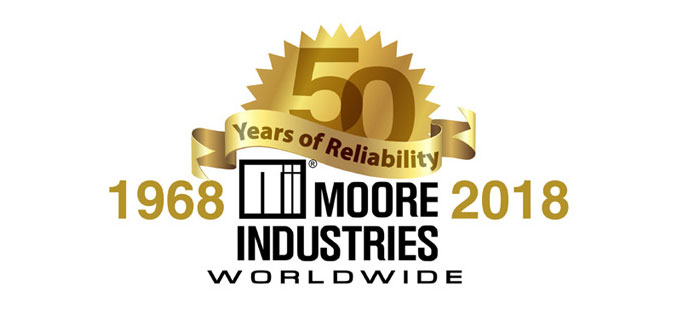
Since 1968, Moore Industries has been proudly serving process manufacturing businesses and fortune 500 companies in oil, gas, mining, chemical, power generation, water/waste water treatment, pharmaceutical, food, beverage, consumer packaged goods, semiconductor, and biotechnology industries. Moore Industries started out with three employees in California and has grown with offices worldwide in the United States, Australia, Belgium, China, the Netherlands and the United Kingdom.
Today Moore Industries is an award winning company that carries on the original mission of making tough and reliable products. As a world leader in the design and manufacture of interface instruments for industrial process control, system integration, and factory automation, the company’s success wouldn’t have been possible without loyal customers. Customer relationships are the primary focus as Moore Industries will continue to provide nothing less than the best quality in process industry products and exceptional services.
Appreciation for customer service and innovation over the years has led to numerous awards and recognition including multiple Control Engineering Product Recognition awards and Automation Excellence Awards. In 2009 Mr. Moore was awarded one of the process industry’s highest honors, ISA Honorary Membership. He also holds a lifetime membership in IEEE.

“Over the years, we have transformed the company’s analog instrumentation lines and solutions into microprocessor and software based smart instrumentation and control products. An overwhelming amount of the company’s long-term success and tenure within the industry belongs to our devoted and hardworking employees,” comments Scott Saunders, President and CEO.
To learn more about Moore Industries products, go to our product page or watch our video.Class Cancelled at this Time.

Moore Industries is proud to host exida’s Security Development Lifecycle Training course on October 2 through October 4, 2018 in North Hills, CA. The course is for developers of industrial control system products with a particular focus on network-enabled embedded control systems. The objective is to train Research & Development teams using a combination of lectures and workshops on how to properly and effectively integrate software security assurance practices and techniques into existing software development lifecycles.
Training covers all phases of IEC 62443-4-1 (Product Development Lifecycle Requirements) as well as IEC 62443-4-2 (Technical Security Requirements for IACS components), and the ISASecure™ Software Development Security Assurance (SDSA) certification program. The length of the course is 3 days.
The course includes topics:
- Security Development Lifecycle Introduction
- PC & Networking Best Practices
- System Integration and Maintenance
- Security Management Process
- Software Exploitation
- Security Requirements
- Software Architecture Design
- Threat Modeling Training
- Module Implementation and Verification
- Security Integration Testing
- Security Validation Testing
- Incident response Planning and Execution
- Document Security Guidelines
To register, visit exida’s site here.
To find out about other exida courses go to exida’s training page.
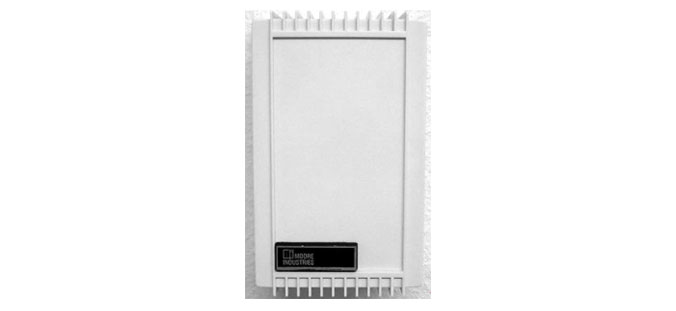
The T2X-DWB Wall-Mount Room Air Temperature Monitoring System delivers the long-term stability of Moore Industries’ T2X transmitter while being enclosed in a durable wall-mounted box. It can be used in a wide range of indoor temperature sensing applications. The PC-programmable T2X-DWB has an internal 1000 ohm RTD for room temperature sensing. It provides a proportional 4-20mA output that is linear with temperature, and ready for direct interface with a monitoring and/or control system.
Features Include:
- Mounts easily to a wall for simple installation
- Sensor placement and vented housing design allow for maximum air flow
- Sets up in a minute or less with single window Intelligent PC Configuration Software
- Provides a proportional 4-20mA output that is ready for direct interface with a monitoring/control system
- Independent input and output scaling capabilities
Do you want more information? Download the data sheet. Or visit the catalog.
Need to get price or availability or have a technical question?
Send us a message using E-Help.
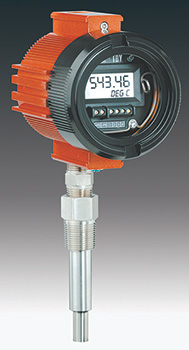
Moore Industries’ universal TDY PC-Programmable Temperature Transmitter features a large integral display that shows real-time process status and valuable loop diagnostic information. Combining smart digital technology with advanced analog operation, the TDY delivers superior reliability, accuracy and ease of use.
- 22 RTD Types (2, 3, or 4-wire; Pt, Cu, or Ni; 10 to 1000 ohms)
- 9 Thermocouple Types (J, K, E, T, R, S, B, N and C)
- Direct Millivolt Sources (-50 to 1000mV)
- Resistance & Potentiometer Devices (0 to 4000 ohms)
The TDY converts the input to an accurate 4-20mA output that is both linear and input scalable-ready to interface to readout instruments, recorders, DCS units and other computer-based SCADA systems.
- The TDY provides the highest accuracy (up to ±0.05°C) for your critical process applications
- Easy-to-read customizable display
- Auto decimal point
- Delivering output updates at least 8 times per second, these transmitters are twice as fast as comparable microprocessor-based instruments
- Sets up in a minute or less
Do you want more information? Download the data sheet. Or visit the catalog.
Need to get price or availability or have a technical question?
Send us a message using E-Help.
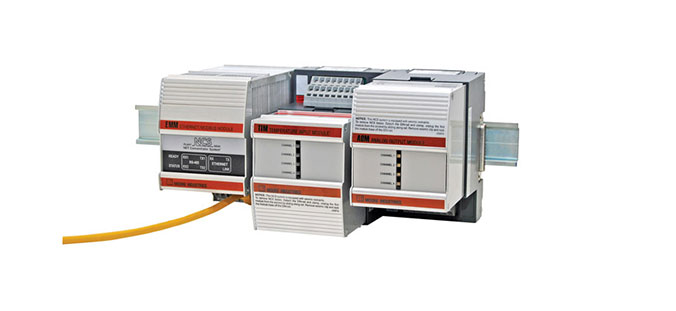
Designed specifically for demanding industrial applications, the NCS NET Concentrator System® provides a real-time signal gateway between the field or factory floor and your control strategy. The NCS is the ideal solution when you need to network new and existing “legacy” process sensors, instruments and final control elements with computer-based monitoring and control systems. Rugged and reliable, it is built to withstand harsh ambient temperature conditions ranging from -40C to +85C (-40°F to +185°F).
Universal and modular, it programs to handle a wide range of signal input and control output possibilities: Current, Voltage, discrete, relay, RTD, Thermocouple, resistance, and potentiometer.
Features include:
- Superior 20-bit input and 18-bit output resolution
- Installs in harsh ambient temperature conditions
- Quick and simple programming
- Industry-standard OPC interface
- Isolation and RFI/EMI protection
- Peer-to-Host and Peer-to-Peer operation
- Transmit any distance, over any terrain
- Data logging capabilities
Do you want more information? Download the data sheet. Or see the NCS module listings in the catalog.
Need to get price or availability or have a technical question?
Send us a message using E-Help.
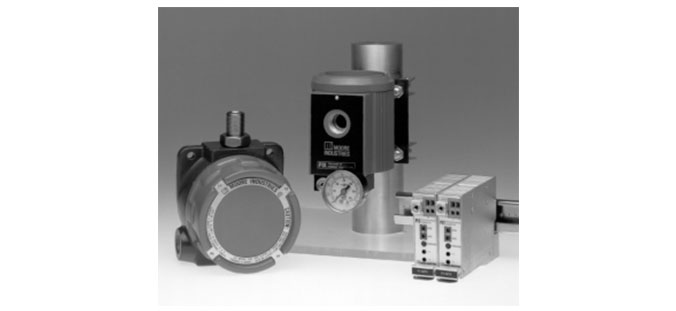
Moore Industries’ family of pressure-to-current transmitters provide an economical solution when a pneumatic device must interface with a data acquisition control system, controller, recorder, or another electronic instrument.
These compact, yet powerful units accept a pneumatic signal (3-15 psig, 0.2-1 bar, 3-27 psig, etc.) and accurately convert it to a proportional 4-20mA (or 10-50mA) output.
Our complete line of P/I transmitters includes models perfect for both control room and field mounting. Moore Industries’ P/I transmitters are available with a wide variety of housings, and with special features and options.
Features include:
- Immune to shock, vibration and position. Perform with exceptional accuracy (±0.2% of span) even in unstable environments
- Mount in any position without performance loss
- Long, trouble-free service life
- Self-sealing pneumatic connection
Do you want more information? Download the data sheet. Or visit the catalog.
Need to get price or availability or have a technical question?
Send us a message using E-Help.
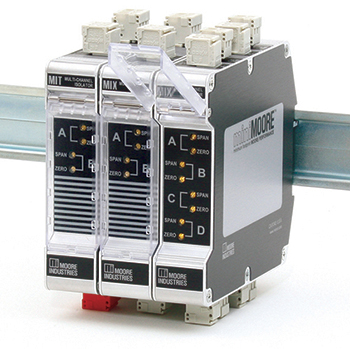 Featuring a very narrow installation footprint, miniMOORE™ Signal Isolators, Converters, Boosters and Splitters combine multiple analog signal channels in a rugged, easy-to-install signal conditioner. Reliable and very economical, the miniMOORE multi-channel family includes the model MIX 2-wire (loop) and the model MIT 4-wire (line/mains) powered models. The complete family delivers cost-effective solutions for an expansive range of signal interface applications.
Featuring a very narrow installation footprint, miniMOORE™ Signal Isolators, Converters, Boosters and Splitters combine multiple analog signal channels in a rugged, easy-to-install signal conditioner. Reliable and very economical, the miniMOORE multi-channel family includes the model MIX 2-wire (loop) and the model MIT 4-wire (line/mains) powered models. The complete family delivers cost-effective solutions for an expansive range of signal interface applications.
Features include:
- High-density, 2- and 4-channel configurations
- Switch-selectable current/voltage inputs. The 2-channel miniMOORE models provide DIP switches for selecting input types of 4-20mA, 0-5V, 1-5V or 0-10V for each channel
- 2-wire (loop) and 4-wire (line/mains) powered
- Superior signal isolation
- Universal AC/DC power input
- RFI/EMI Protection
Visit the MIX / MIT product page.
Do you want more information? Download the data sheet. Or visit the catalog.
Need to get price or availability or have a technical question?
Send us a message using E-Help.
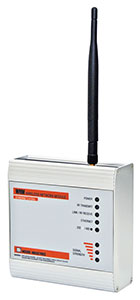 The WNM is a bi-directional, spread spectrum radio modem that delivers the flexibility and cost-saving advantages of wireless data transmission. It is ideal for use with Moore Industries’ NET Concentrator System® (NCS), as well as other SCADA and distributed I/O systems. The WNM is a bi-directional, spread spectrum radio modem that delivers the flexibility and cost-saving advantages of wireless data transmission. It is ideal for use with Moore Industries’ NET Concentrator System® (NCS), as well as other SCADA and distributed I/O systems.
The WNM is a bi-directional, spread spectrum radio modem that delivers the flexibility and cost-saving advantages of wireless data transmission. It is ideal for use with Moore Industries’ NET Concentrator System® (NCS), as well as other SCADA and distributed I/O systems. The WNM is a bi-directional, spread spectrum radio modem that delivers the flexibility and cost-saving advantages of wireless data transmission. It is ideal for use with Moore Industries’ NET Concentrator System® (NCS), as well as other SCADA and distributed I/O systems.
The WNM employs Spread Spectrum Frequency Hopping technology, 128-bit AES (Advanced Encryption Standard) encryption, 32-bit CRC (Cyclic Redundancy Check) error detection, and ARQ (Automatic Resend Query) to provide robust and secure communications. The Spectrum Frequency Hopping technique ensures reliable, noise and interference immune, license-free wireless communications.
Features Include:
- Standard Operating Frequencies - Available models operate at frequency ranges of 902-928MHz or 2.4-2.4835GHz (RF ranges and power factory configured per country)
- Long-Distance Data Transmission - The 902-928MHz units can transmit up to 30 miles(48km); 2.4-2.4835GHz units provide up to 15 miles (24km) transmission range. WNM modules configured as repeaters allow for virtually unlimited transmission range
- Supports Ethernet and Serial Communications
- Plug-and-Play Installation and Operation
- No Regulatory License Required
Visit the WNM product page for more information.
Do you want more information? Download the data sheet. Or visit the catalog.
Need to get price or availability or have a technical question?
Send us a message using E-Help.
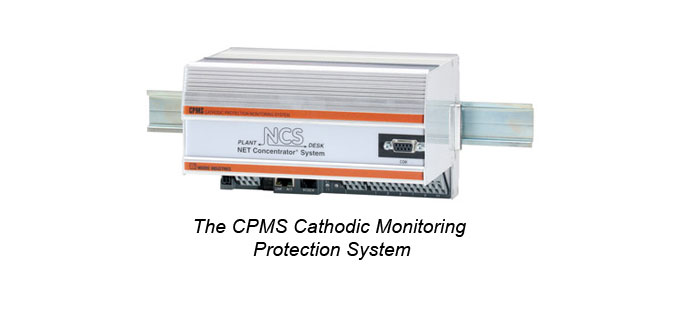 The CPMS Cathodic Protection Monitoring System monitors above and below ground impressed current cathodic protection systems to ensure that proper corrosion protection is in place and operating at the right levels. The CPMS Cathodic Protection Monitoring System monitors above and below ground impressed current cathodic protection systems to ensure that proper corrosion protection is in place and operating at the right levels.
The CPMS Cathodic Protection Monitoring System monitors above and below ground impressed current cathodic protection systems to ensure that proper corrosion protection is in place and operating at the right levels. The CPMS Cathodic Protection Monitoring System monitors above and below ground impressed current cathodic protection systems to ensure that proper corrosion protection is in place and operating at the right levels.
Part of Moore Industries’ NET Concentrator System® family of intelligent distributed I/O, the CPMS monitors the critical current and voltage levels of one or two transformer rectifi ers used in cathodic protection systems. Each module provides four or eight, fully-isolated analog input channels and four discrete (contact closure) inputs. It “concentrates” this data onto one or multiple communication links, and transmits it long distances back to one or more host DCS, PLC or PC-based control systems.
The CPMS accepts up to four discrete (contact closure) inputs from the monitored system. Using an internal control engine, the CPMS can be programmed with internal set points that relate to normal operating conditions within the cathodic protection system. Should monitored parameters go outside of selected limits, or if power to the cathodic protection system is lost, the CPMS alerts of the unwanted conditions at the control system over the data link.
In addition to operating in a stand-alone mode, the CPMS integrates with any of Moore Industries’ NET Concentrator System’s analog, temperature, discrete and relay I/O modules. When coupled with the ROM (Relay Output Module), relay outputs can control rectifiers using accurate GPS time to facilitate taking cathodic protection reference electrode readings.
Features Include:
- Simultaneous dual MODBUS RTU and Ethernet communications
- MODBUS RTU master capability
- Installs in harsh environments
- Quick and simple programming
- Data logger with battery back-up
- Advanced control and math capabilities
- GPS Time feature
Visit the CPMS product page. Download the CPMS data sheet.
Need to get price or availability or have a technical question?
Send us a message using E-Help.
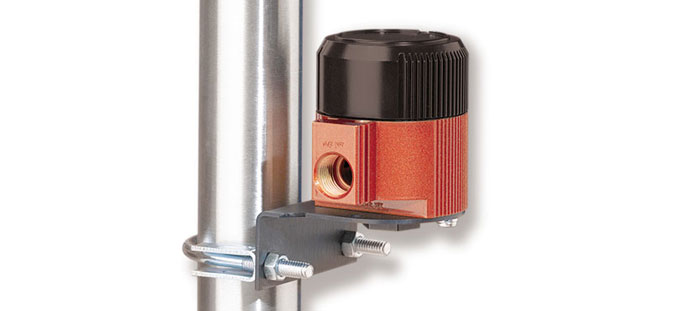 Moore Industries’ durable PIH Pressure-to-Current Transmitter provides an economical solution for any process that requires a rugged instrument capable of interfacing a pneumatic device with a data acquisition/control system, controller, recorder, or other electronic instruments. Moore Industries’ durable PIH Pressure-to-Current Transmitter provides an economical solution for any process that requires a rugged instrument capable of interfacing a pneumatic device with a data acquisition/control system, controller, recorder, or other electronic instruments.
Moore Industries’ durable PIH Pressure-to-Current Transmitter provides an economical solution for any process that requires a rugged instrument capable of interfacing a pneumatic device with a data acquisition/control system, controller, recorder, or other electronic instruments. Moore Industries’ durable PIH Pressure-to-Current Transmitter provides an economical solution for any process that requires a rugged instrument capable of interfacing a pneumatic device with a data acquisition/control system, controller, recorder, or other electronic instruments.
This compact yet powerful unit accepts most pneumatic signals (3-15 psig, 0.2-1 bar, 3-27 psig, etc.) and accurately converts them to a proportional 4-20mA output. The PIH is perfect for field mounting. Its metal casing makes it a tough field-mount unit when you need strength without the added expense of an explosion-proof enclosure.
Features Include:
- Perfect for harsh field environments
- Saves installation costs
- Immune to shock, vibration, and proportional
- RFI/EMI protectionReverse Output Option
- Visit the product page & download the PIH data sheet.
Need to know more about a product, price or availability? Check out the PIH Pressure-to-Current Transmitter
Do you want more information? Download the data sheet. Or visit the catalog.
Need to get price or availability or have a technical question?
Send us a message using E-Help.
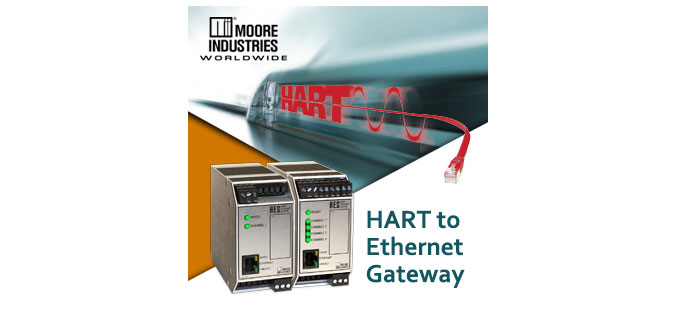 Timely knowledge about your process enables better decisions and faster preventive action. Now you can get the process detail that you need from your Smart HART devices to MODBUS/TCP and HART-IP based monitoring and control systems at the speed of Ethernet with the HES HART to Ethernet Gateway System from Moore Industries.
Timely knowledge about your process enables better decisions and faster preventive action. Now you can get the process detail that you need from your Smart HART devices to MODBUS/TCP and HART-IP based monitoring and control systems at the speed of Ethernet with the HES HART to Ethernet Gateway System from Moore Industries.
Connect up to 64 Smart HART devices to the HES and collect the Dynamic Variables and the Device Variables, along with diagnostic bits and bytes, from each device that helps deliver critical information needed to help you address process and device problems before they turn into unplanned downtime.
Whether you need data from one device or many, the HES meets your need with a single channel and four channel configurations. The single channel configuration supports up to 16 HART devices in digital multidrop mode, or it can support one device in a standard point-to-point 4-20mA loop configuration. The four channel configuration can support up to 64 total HART devices for high-density installations.
The HES supports HART field devices both old and new with HART 5, 6 and 7 revisions, including devices such as Coriolis, magnetic, vortex, ultrasonic and multivariable mass flowmeters along with pressure, pH, level, temperature transmitters, and even smart valve positioners. Its robust memory capacity can handle thousands of process variable and diagnostic data points from connected smart HART devices.
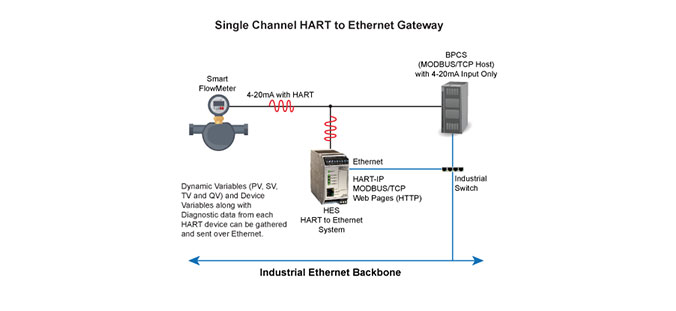
The HES is simple to configure over Ethernet using PACTware or other FDT compliant host with supplied HES DTM. Easy-to-use menus give you the ability to fully configure the HES including HART channel communications, MODBUS communication, and mapping settings and network security parameters.
You can view all of the HART data from connected field devices in read-only mode with any web browser via the HES’ built-in web server or a MODBUS/TCP compliant host. The HES also supports HART-IP, which allows you to monitor any of the connected HART device variables, HES variables, or diagnostics. Support for these open industrial protocols enables interface with any process control or asset management system while taking advantage of any Industrial Internet of Things (IIoT) initiatives that facilitate the propagation of process data to higher level corporate or analytical systems.
The new HES continues the Moore Industries reputation for rugged and reliable products that are designed and built to perform dependably year after year.
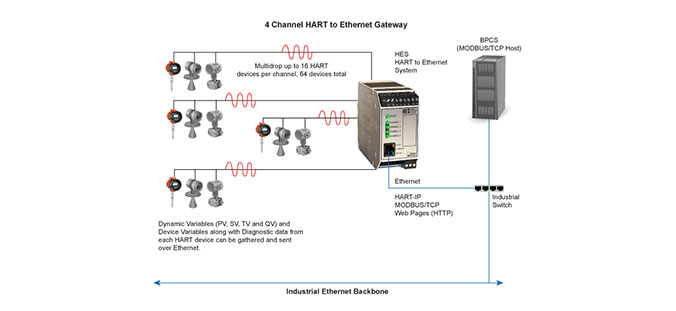
Demand Moore Reliability
Do you want more information? Download the data sheet. Or visit the catalog.
Need to get price or availability or have a technical question?
Send us a message using E-Help.
HART LINE Newsletter, June 2000
Most users of smart HART devices know how to use their hand-held HART Communicators for configuration and for the occasional loop check. Few, however, take advantage of the inherent capability of HART devices to provide valuable diagnostic and preventative maintenance information. In this article, Bud Adler, our Director of Professional Development, discusses the benefits of using HART Loop Monitors to "look inside" smart valves and transmitters, and determining what is wrong and even predicting problems before they occur.
View Article (PDF, 53K)
Canadian Process Equipment & Control News, March 2000
Our very affordable THZ Smart HART Temperature Transmitter was chosen by the editor of Canada's leading industrial-process-controls magazine for its exceptional accuracy (better than twice that of comparable transmitters). The THZ sets up with a standard hand-held HART communicator, with an AMS, or with our free PC-based configuration program featuring a comprehensive on-line help system called HelpMap.
View Article (PDF, 392K)
Plant Services Magazine, February 2000
A new breed of smart transmitters can help optimize maintenance and operations by putting the user in control. Our temperature expert and Vice President of Engineering Joe Hage covers how the powerful features of smart temperature transmitters increase functionality, speed installation, sharpen measurement accuracy, trim maintenance costs, and provide a wealth of valuable diagnostic information.
View Article (PDF, 920K)
Control Magazine, January 2000
For 8 YEARS IN A ROW, we've been voted #1 for Signal Interface instruments by process instrumentation users. We are also very proud to be rated the #2 choice for temperature transmitters (against some pretty big competition), and the VERY BEST in customer service for both signal interface and temperature transmitter technology.
View Article (PDF, 88K)
IAN Magazine, January 2000
Our smarter-than-smart TDZ HART Temperature Transmitter was chosen by Patricia Pool, the Editorial Director of Instrumentation & Automation News (IAN), for the front and center cover position of this millennium's first issue of IAN magazine. The TDZ features industry-leading measurement accuracy, an easy-to-read process display, and FM hazardous area approvals.
View Article (PDF, 115K)
Control Magazine, December 1999
The last issue of the millennium of Control magazine, a leading technical publication in the United States, includes an excellent article entitled "100 Years of Process Automation." It impressively chronicles scientific breakthroughs and innovations in the process industries over the past century. Featured in the article, in the historical timeline, is our CCS Cable Concentrator System. Listed as a forerunner of the modern fieldbus strategies, the CCS's ability to concentrate hundreds of analog and discrete signals onto one twisted wire pair made history when it was first introduced in 1987. For information on our CCS Cable Concentrator System, and our other lines of money-saving, intelligent distributed I/O products, see our selection guide.
Control Magazine, September 1999
In this exclusive product review, Joe Hage (our Vice President of Engineering) states proudly that "The TDZ is so accurate, you could actually use it as a precision current source to calibrate process instruments." Take a look at this article, and the TDZ data sheet, and you'll see why Joe has good reason to be proud. The TDZ's universality, large process display, long-term stability and HelpMap interactive help guide are just a sample of the advanced features covered in the article.
View Article (PDF, 109K)
I&CS Magazine, August 1999
I&CS Magazine's Senior Technical Editor, Tom Polischuk, gives our new THZ Smart HART Temperature Transmitter a glowing review. He draws special attention to the instrument's exceptional accuracy when matched with our precision RTD thermowell assemblies.
View Article (PDF, 101K)
Process Heating Magazine, June 1999
Moore Industries' temperature expert Gary Prentice explains the top reasons why temperature transmitters are a better choice than direct wiring RTD and Thermocouple sensors directly back to a readout/control system. Colorful illustrations and photographs reinforce Gary's argument.
View Article (PDF, 384K)
Control Engineering Magazine, June 1999
In this sidebar to Control Engineering's feature article on multivariable transmitters, Moore Industries' Senior Applications Specialist Matt Moren tells how a Smart HART Loop Monitor will facilitate the migration to smart instruments.
View Article (PDF, 34K)
I&CS Magazine, June 1999
High-accuracy temperature transmitters matched with precision sensors will cost you a little more initially, but will save you time and money in the long run by improving yields and reducing maintenance costs. Applications specialists Lori Risse and Greg Vonada provide an in-depth analysis of the advantages of high-accuracy temperature strategies.
View Article (PDF, 291K)
CONTROL Magazine, January 1999
For seven years in a row, Moore Industries has been selected as the Number 1 choice for Signal Conditioners by the readers of top industry publication CONTROL magazine.
The ranking is based on a comprehensive survey of instrumentation, process, systems, and plant engineers in every segment of the process industries. We also earned high marks for our responsive Customer Service and Smart Temperature Transmitters.
View Details (PDF, 58K)
Control and Instrumentation Magazine, 1999 Product Survey Directory
Authored by Rob Stockham, General and Marketing Manager of Moore Industries-Europe, this article discusses the cost and time-saving benefits, and performance-enhancing advantages of using intelligent temperature transmitters in place of direct wiring schemes.
View Article (PDF, 124K)
I&CS Magazine, September 1998
The use of smart loop monitors can save manpower costs and maintenance time, and prevent false shutdowns. This article by Joe Hage, Moore Industries' Vice President of Engineering, describes the advantages of using loop monitors, such as Moore Industries' SPA HART Alarm, in important monitoring scenarios.
View Article (PDF, 410K)
Control Systems Magazine, October 1998
Process signal conditioning was born out of the need to deal with the myriad of process signal types. Rob Stockham, General and Marketing Manager of Moore Industries-Europe, recalls the history of signal conditioning and looks to its future.
View Article (PDF, 121K)
Control Engineering Magazine, June 1998
On the surface, direct wiring temperature sensors directly to your DCS or PLC seems cheaper. But in the long run (especially with long sensor runs) is it really? Lori Risse, Marketing Research Specialist for Moore Industries, gives the basics of why using temperature transmitters is better than direct wiring sensors to your readout and monitoring systems.
View Article (PDF, 58K)
SENSORS Magazine, September 1997
To be sure of getting the temperature measurements you need for a process application, brush up on the options you'll have to consider when selecting an RTD. In this technical article, Moore Industries Application Engineer J.R. Madden tells what you should keep in mind when choosing an RTD for your application.
View Article (PDF, 359K)
I&CS Magazine, June 1997
Moore Industries prides itself on being customer-driven. In this article by Consulting Editor Jack Hickey, Len Moore, Moore Industries' founder and chairman of the board, talks candidly about the company's past, present, and future.
View Article (PDF, 497K)
I&CS Magazine, June 1997
Smart HART transmitters and valves are capable of providing a wealth of information beyond a simple 4-20mA process measurement. Yet they are rarely employed to do so because most monitoring and control systems won't handle HART digital data. Peter Cleaveland, Senior Technical Editor, discusses how Moore Industries' industry-first SPA Site-Programmable HART Alarm can help you take full advantage of the HART protocol.
View Article (PDF, 194K)
Plants in many industries have large demands for clean water. Monitoring and controlling the flow rate is critical for billing and usage requirements.
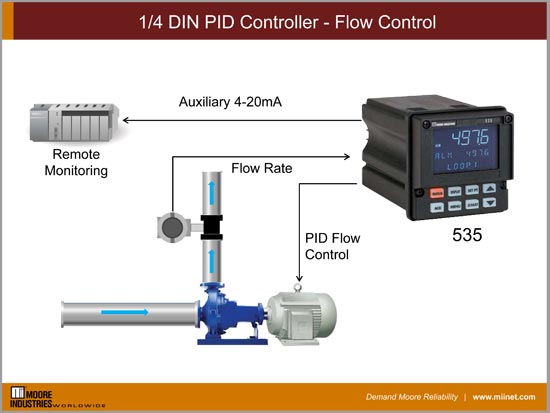
When accurate and repeatable flow control is required, consider the NEMA 4X Model 535 ¼ DIN Single Loop Controller. This versatile yet easy to program controller can perform P, PI, or PID control with built-in auto-tuning and other advanced programming features. The controller features a large vacuum fluorescent display with a large five-digit upper display and two nine-character lines of alphanumerics. In addition to the CV (Control Variable) output, up to three additional relay or analog outputs can be configured.
Key Attributes:
- Easy to setup and configuration menu
- Easy to use PID auto-tuning
- Large display and additional outputs
Water plants usually have several filter beds that are controlled by a DCS, PLC or PID controller. However, there are times when manual control close the filter bed is needed by a plant operator.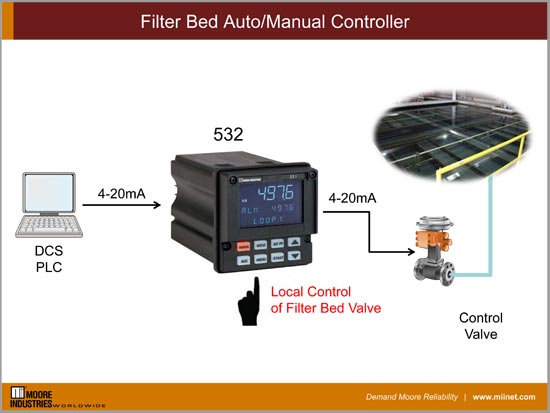
When this need arises, look to the 532 ¼ DIN Auto/Manual Station. The Nema 4X UL approved 532 allows the control signal (CV) to pass through the controller to the final control element in the normal mode. When local control is required the operator simply presses the MANUAL button on the controller to take control of the 4-20mA signal that is driving the final control element. The 532 features a large vacuum fluorescent display with a large five digit upper display and two nine character lines of alphanumerics. Additionally, soft and hard alarms can be set to notify when the 532 has been put in local MANUAL mode.
Key Attributes:
- Easy to use push button auto/manual station
- Large display with local indication of PV and CV
- NEMA 4X case with UL Approval
Pharmaceutical facilities have critical monitoring points that if not measured closely could cause serious injury to personnel. Often these critical signals need to be shared with other control devices and wiring them in series with one another is not always a good idea since a failure at one receiving device renders the loop open, or in a failed state. Pharmaceutical facilities have critical monitoring points that if not measured closely could cause serious injury to personnel. Often these critical signals need to be shared with other control devices and wiring them in series with one another is not always a good idea since a failure at one receiving device renders the loop open, or in a failed state.
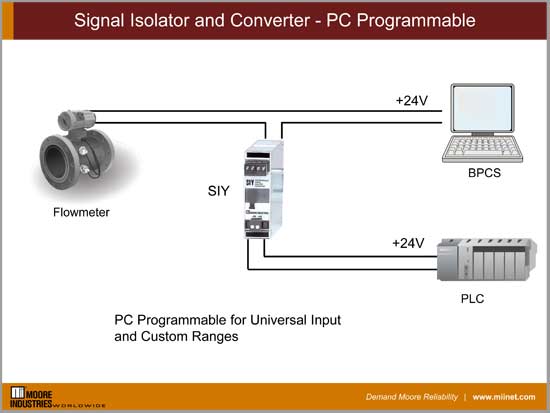
If you have critical loops like these consider looking to the SIY PC Programmable Signal Isolator. The SIY is a rugged and reliable two-wire, output loop powered isolator that can be PC programmed for just about any input, standard or special range. Additionally, the SIY allows you to create custom curves for those non-linear signals. This form of area isolation affords you the protection and added safety by not having to worry about losing your primary control loop when you work on your secondary backup-side loop, and vice versa.
Key Attributes:
- SIY is PC programmable for just about any input range
- Field mount version available with worldwide hazardous area approvals
- No exposed potentiometers for unauthorized calibration or adjustments
Process rooms and ventilation systems require tight humidity control in pharmaceutical facilities. Process rooms and ventilation systems require tight humidity control in pharmaceutical facilities.
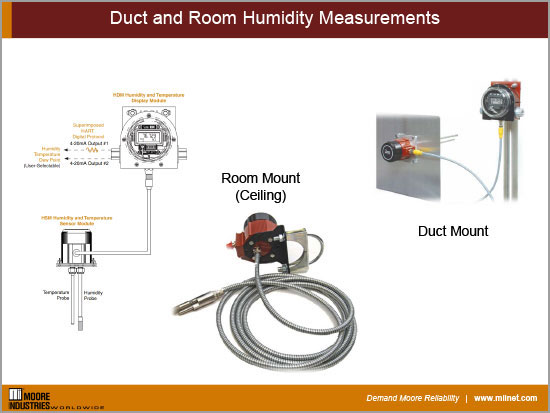
The HART Smart HTZ Humidity and Temperature Transmitter allow the accurate monitoring of humidity, temperature and dew point. Two probe designs off the flexibility for either duct mount or room monitoring. The duct mount sensor assembly comes standard with a mounting plate and wing nuts to ensure a well-sealed process connection. The room mount version features a flexible armor cable sensor that can be mounted from the ceiling so the height of measurement can be easily adjusted. Moreover, this flexible sensor prevents accidental damage since the equipment is often moved around in batch processing areas.
Key Attributes:
- Humidity or Dew Point Measurements
- Programmable via HART or Free Intelligent PC programming software
- Flexible sensor design allows mounting in small process rooms at adjustable heights
Wafer tools typically need deionized water and other chemicals in the masking process that requires tight control of small valves.
![]()
Since these control valves are too small to accommodate a field mounted I/P or positioner, the highly accurate and repeatable two-wire loop-powered IPT2 DIN mount Current-to-Pressure Transmitter is a perfect solution. The IPT2 can be rack mounted for high-density installations in 5, 10, or 15 position racks that simplify air supply, filtering and regulation due to its backplane header design. The IPT2 includes a pneumatic closed-loop feedback circuit for optimum control, has front mounted test leads to monitor the input, and offers an optional front-mounted pneumatic test jack.
Key Attributes:
- Highly accurate and repeatable
- Excellent resistance to vibration and closed-loop feedback circuit
- High-density installation option
Semiconductor locations require tight temperature control of their HVAC systems. Semiconductor locations require tight temperature control of their HVAC systems.
![]()
Sometimes there are two separate systems that need to monitor temperature points; one for control and one for data archiving. Rather than wiring a 4-20mA signal in series through two host systems, consider using a signal splitter like the ECT. The UL approved ECT signal splitter allows both systems to monitor temperature but now neither system can affect the other when there is a failure or maintenance issue on the other loop.
Key Attributes:
- Full four-way isolation up to 500Vrms between power and all input/outputs
- RFI/EMI resistant and hardened aluminum case
- Zero and span potentiometers for on-site calibration
Power generation, water, and pulp & paper plants often have process points that are added after the initial plant build. Sometimes the DCS has run out of I/O points or spare twisted pair doesn’t exist. Many plants have process points that are added after the initial plant build. Sometimes the DCS has run out of I/O points or spare twisted pair doesn’t exist.
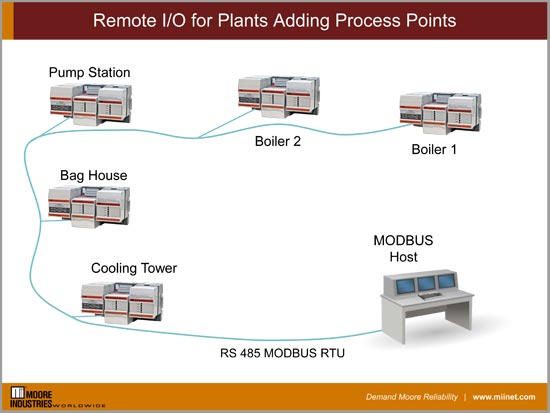
When such a requirement exists, the NCS Net Concentrator System remote I/O product simplifies the task of gathering signals scattered through multiple processing units or locations. The NCS is Class I Div 2/Zone 2 approved and accepts a wide range of inputs including RTD, TC, Ohms, Potentiometer, mV, mA and Volts. Each NCS remote I/O station can accept up to 128 I/O points. It supports RS-485 MODBUS RTU so up to 32 NCS systems without repeaters can be multi-dropped on one twisted pair and brought back to a MODBUS host monitoring system. The easy to configure NCS has 500V of channel-to-channel isolation and has an ambient operating temperature specification of -40 to 85C (-40 to 185F).
Key Attributes:
- The wide range of I/O types and number of points
- Class I Div 2/Zone 2 approval
- MODBUS RTU support
Many facilities have hundreds of motors installed throughout various processing units. Monitoring of these motors for more precise control or protection is paramount.
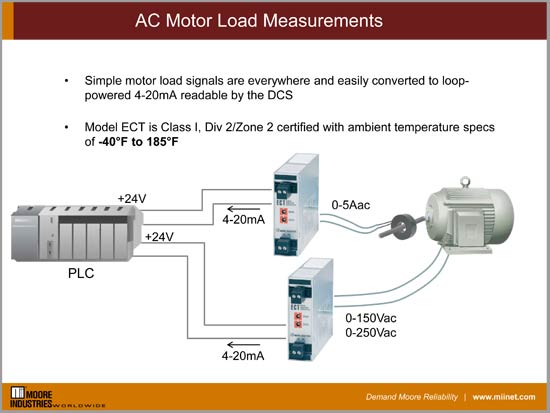
The model ECT is a Class I Div 2/Zone 2 DIN rail, loop-powered (two wire) signal converter with an operating range of -40 to 85C (-40 to 185F) that accepts AC current inputs of up to 0-5A AC and outputs a linear and noise-free 4-20mA signal readable by the BPCS or PLC. As an added safety feature, the ECT offers an optional externally mounted mini-CT (Current Transformer) that steps 0-5A AC down to 0-5mA AC so technicians don’t have to worry about handling high current signals. ECT also accepts high-level AC voltage inputs too.
Key Attributes:
- Two wire loop-powered AC signal converter
- Class I Div 2/Zone 2 approvals
- High ambient operating temperature range of -40 to 85C (-40 to 185F)
In order to keep Natural Gas pipelines operational, compressor stations are located every 50 miles or so. These compressors have critical temperatures that need to be monitored including bearing, lube oil, discharge and suction temperature. Due to the criticality of these temperatures a Safety Instrumented System (SIS) may be implemented to protect the compressor and personnel.

If an SIS is employed, the Class I Div 2/Zone 2 STA Functional Safety Trip Alarm, that is exida certified and SIL 2/3 capable, can provide the logic solver needs for the high-temperature shutdown circuit. The STA offers a simple programming interface, local indication, and retransmission of critical temperatures to a remote host or SCADA system.
Key attributes:
- STA is exida certified and SIL 2/3 capable logic solver
- Simple programming interface vs complex safety PLC
- Provides local indication and auxiliary analog output
Upstream and midstream oil and gas locations are always looking for ways to cut costs. Since their sites typically have hazardous gasses and vapors present, their wiring methods and instruments have to be rated Class I Div 1.
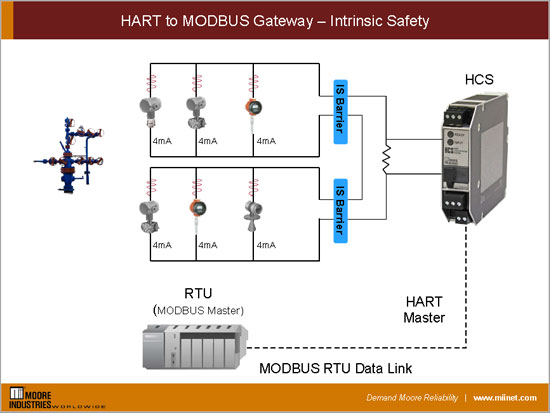
One consideration to reduce your cost per point monitoring at these sites is to utilize the HCS HART Concentrator System by reading the HART signal from your field instruments. HART allows multiple instruments to be installed on a single twisted pair. Rather than using an individual twisted pair per instrument and Intrinsically Safe barriers or hard conduit, you can use one HCS and one IS barrier with multidropped instruments on one twisted pair and convert the HART data to MODBUS RTU. The HCS can accept up to 16 multidropped instruments. The actual number of multidropped transmitters is dependent upon the power your IS barrier allows into the field. The local RTU can then read multiple instruments via the MODBUS RTU signal. The HCS is approved for installation in Class I Div 2/Zone 2 areas and supports both RS-232 and RS-485 physical layer networks. The HCS is configured via a free Windows PC program and sets up in just a few minutes.
Key Attributes:
- Polls between one and 16 HART instruments and converts data to MODBUS RTU
- Class I Div 2/Zone 2 approval
- -40 to 85C ambient operating temperature
Mining facilities have far-reaching and remote locations that need to be monitored. Often these locations have limited wiring and are miles apart. Mining facilities have far-reaching and remote locations that need to be monitored. Often these locations have limited wiring and are miles apart.
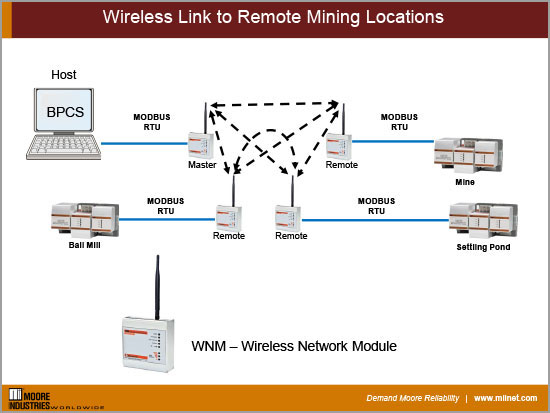
To solve this dilemma look to the WNM Wireless Network Module. The WNM is a 900Mhz or 2.4Ghz License Free Spread Spectrum Radio that can cover up to 30 miles (without repeaters) between locations. Each WNM can be programmed to be a Master, Remote, Repeater or Remote/Repeater. The WNM is certified for installation in Class I Div 2/Zone 2 locations and supports Ethernet and MODBUS RTU communication links, therefore, making it an ideal interface with almost all remote I/O systems, including the NCS Net Concentrator System shown here.
When temperature points need to be monitored in hazardous locations where explosive atmospheres can occur, consider using an Associated IS temperature transmitters, especially when the method of protection is Intrinsic Safety. When Intrinsic Safety (IS) is chosen as the facility's protection method, intrinsically safe barriers for all of the RTD and TCs can be quite expensive, engineering intensive and space consuming.
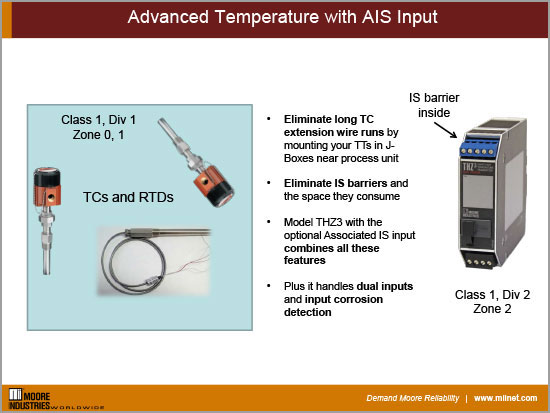
One solution to this problem is to install DIN rail temperature transmitters in the field, close to the process, that has built-in intrinsically safe barriers. The THZ3 DIN rail temperature transmitter is considered an associated IS device because it has the IS barrier embedded in the transmitter so it can connect to temperature elements that are located in Class I Div 1 or Zone 0/1 hazardous areas. Moreover, by implementing this strategy you eliminate the common drift and corrosion problems associated with long TC lead wire runs that lead to expensive and troublesome measurement errors.
Key Attributes:
- IS barrier built into THZ3, reducing needs for external IS barriers
- Eliminate errors due to TC extension wire
- Dual input capability and input corrosion detection
Industrial compressors are often used in large chemical plants to supply headers with air for pneumatic instruments and valves. These compressors have to run at precise speeds. If these compressors start to run too fast they can become very dangerous and expensive to repair. Industrial compressors are often used in large chemical plants to supply headers with air for pneumatic instruments and valves.
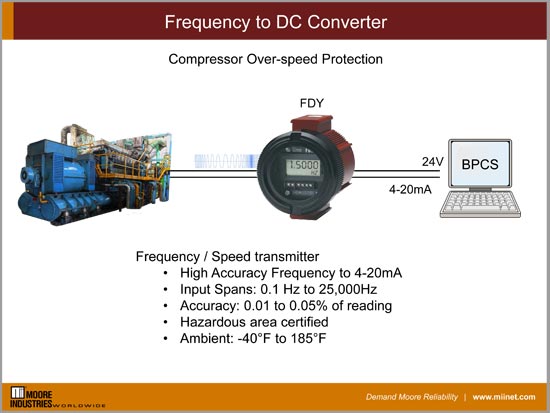
These compressors have to run at precise speeds. If these compressors start to run too fast they can become very dangerous and expensive to repair.
If you have compressors or rotating equipment that is critical, consider the FDY PC Programmable Frequency-to-DC Converter to help provide compressor overspeed protection. The FDY monitors frequency, period, high or low pulse width, and contact closure signals and converts it to a linear and isolated 4-20mA signal. The two-wire loop powered FDY has worldwide hazardous areas approvals and sets up in just a few minutes with easy to use PC programming software.
Key Attributes:
- Universal programmable input
- Local display and Free PC programming software
- Worldwide hazardous area approvals
Steam generation is often a primary source for the heating of fluid processing, chemical processing units, and reactors and therefore maintaining efficient boiler control is critical. Boilers can sometimes suffer flameouts due to poor fuel quality or insufficient oxygen. TCs can be used to monitor boiler tips. Traditionally TCs were wired directly back to a BPCS or PLC with thermocouple extension wire.
Thermocouple extension wire is not only expensive but can be a source or measurement error over time due to the integrity and composition of the extension wire. When boiler tip monitoring is required consider using the NCS Net Concentrator System remote I/O. The NCS accepts universal temperature inputs and is scalable for just a few or hundreds of I/O points. Each NCS can then be placed on an Ethernet backbone for centralized monitoring. If Ethernet is not an option the NCS also supports RS-485 MODBUS RTU networks. Every NCS channel provides 500Vrms channel-to-channel isolation which is important for thermocouples. Approved for installation in Class I Div 2/Zone 2 locations, the NCS is an ideal choice when you need a compact remote I/O solution.
Key Attributes:
- Universal temperature inputs
- Full channel-to-channel isolation
- Ethernet or RS-485 network support
 Australia exported $34 billion in coal in 2015-2016 which has made it the largest global coal exporter by volume (Australian Government, 2016). There are 44,000 people directly employed in the coal industry making safety in mines an important issue. Moore Industries works hard to provide peace of mind with the reliability and ruggedness industry has come to depend on. The Moore Industries FS FUNCTIONAL SAFETY SERIES exida® SIL 2 and SIL 3 capable STA Safety Trip Alarm performs as a logic solver and acts on potentially hazardous process conditions to meet the needs of safe mine transportation.
Australia exported $34 billion in coal in 2015-2016 which has made it the largest global coal exporter by volume (Australian Government, 2016). There are 44,000 people directly employed in the coal industry making safety in mines an important issue. Moore Industries works hard to provide peace of mind with the reliability and ruggedness industry has come to depend on. The Moore Industries FS FUNCTIONAL SAFETY SERIES exida® SIL 2 and SIL 3 capable STA Safety Trip Alarm performs as a logic solver and acts on potentially hazardous process conditions to meet the needs of safe mine transportation.
The Problem
Properly working underground coal mine hydraulics, used to operate the control of the braking system of the winder, is vital when moving mine personnel underground or bringing them to the surface. It is extremely important to ensure that the machine is stopped if low or high pressure is detected online from the hydraulic pump that operates the winder. With personnel safety involved, we can't afford any cable slip.
The Solution
The STA, SIL 2 and SIL 3 Capable Programmable Current/Voltage Safety Trip Alarms are utilized for mine winder monitoring. The STA warns of unwanted process conditions, provides emergency shutdown, or provides on/off control in Safety Instrumented Systems (SIS) as well as traditional alarm trip applications.
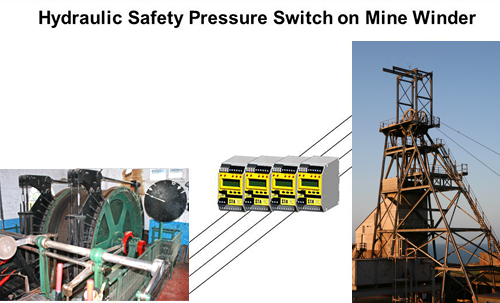
The STA makes an excellent choice for monitoring hydraulic pressure on the Mine Winder and assuring it will shut down the winder should any pressure changes occur.
Contact Moore Industries-Pacific Basin/Asia for your needs in Australia.
References
Australian Government, Department of Industry, Innovation, and Science. (2016, December). Australia's major export commodities coal. Retrieved from https://industry.gov.au/resource/Mining/AustralianMineralCommodities/Documents/Australias-major-export-commodities-coal-fact-sheet.pdf
Do you want more information? Check out the STA datasheet or the Functional Safety - IEC 61508 line card line card.
Need to know more about a product, price or availability? Send us a message using E-Help.
The Problem
A pulp and paper mill had a black liquor BMS (Burner Management System) that per NFPA 85 requires that its safety logic system be totally independent from other logic systems. The challenge was they required that key temperature and pressure signals also get monitored and recorded by their BPCS (Basic Process Control System).
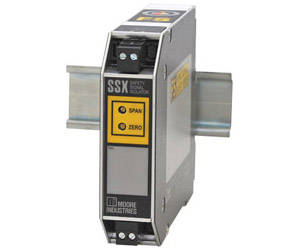
The Solution
The SSX Functional Safety Isolator with HART pass through capability was designed for Safety Instrumented Systems (SIS) and safety applications. The SSX is designed to provide full isolation between a safety system and a non-safety system. The two-wire loop-powered SSX has a passive input and is powered by the output loop side that is connected to the BPCS. Therefore even if power is lost on the BPCS side of the loop, the safety loop functions without interruption. According to IEC 61508 the SSX is a Type A device and per exida is suitable for SIL 3 applications. An exida approved FMEDA report is provided for the SSX safety isolator to assist the safety practitioner with the safety loop implementation.
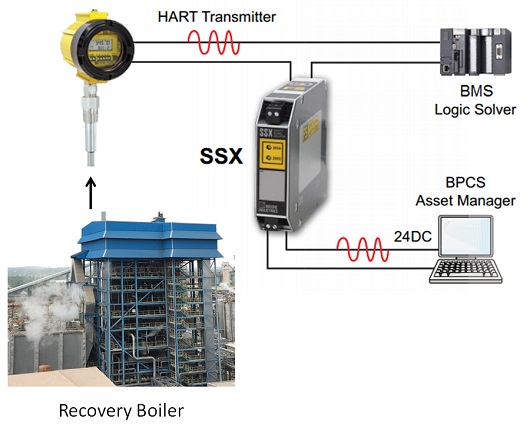
Learn more about the SSX Functional Safety Isolator and the entire family of Moore Industries Functional Safety Series.
Need to get price or availability or have a technical question? Send us a message using E-Help.
 At the Hanford Site KW-Basin Sludge Treatment Project in southeastern Washington, the Department of Energy (DOE) employs multiple NCS Net Concentrator Systems to automate communications among numerous sludge conversion process skids. According to Hanford’s website:
At the Hanford Site KW-Basin Sludge Treatment Project in southeastern Washington, the Department of Energy (DOE) employs multiple NCS Net Concentrator Systems to automate communications among numerous sludge conversion process skids. According to Hanford’s website:
“Nowhere in the DOE Complex is cleanup more challenging than at the Hanford Site in southeastern Washington. Hanford made more than 20 million pieces of uranium metal fuel for nine nuclear reactors along the Columbia River.
Five huge plants in the center of the Hanford Site processed 110,000 tons of fuel from the reactors, discharging an estimated 450 billion gallons of liquids to soil disposal sites and 56 million gallons of radioactive waste to 177 large underground tanks. Plutonium production ended in the late 1980s.
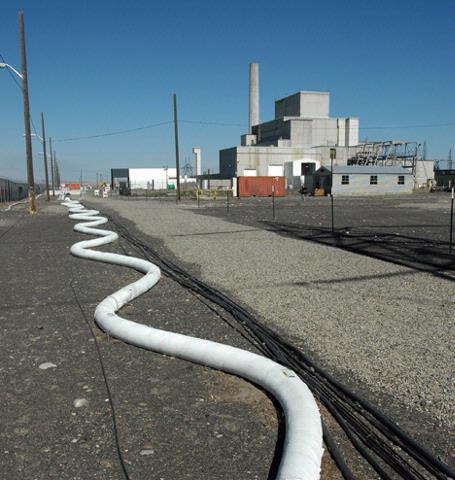 Hanford cleanup began in 1989, when a landmark agreement was reached between DOE, the U.S. Environmental Protection Agency, and Washington State. Known as the Tri-Party Agreement, the accord established milestones for bringing the Hanford site into compliance with federal and state environmental regulations.”
Hanford cleanup began in 1989, when a landmark agreement was reached between DOE, the U.S. Environmental Protection Agency, and Washington State. Known as the Tri-Party Agreement, the accord established milestones for bringing the Hanford site into compliance with federal and state environmental regulations.”
However, as skids were progressively added, management recognized they were outgrowing manual intervention methods and NCSs (Net Concentrator System) were installed and programmed in order to allow automatic communication among the skids. Production personnel could now oversee the process from a control room rather than walking the production floor and could redirect communication links through various skids should some skids be underutilized or offline.
Each sludge processing skid includes a Moore Industries NCS that includes an Ethernet communications port and several channels of discrete and analog input/output channels. 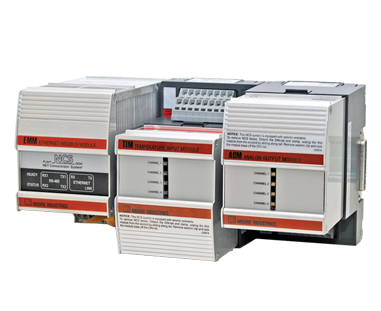 These channels monitor skid mounted gauges and control valves/gates. The NCS also has an embedded real time control engine that supports IEC 1131-3 control logic communication programming via ISaGRAF software.
These channels monitor skid mounted gauges and control valves/gates. The NCS also has an embedded real time control engine that supports IEC 1131-3 control logic communication programming via ISaGRAF software.
Utilizing the ISaGRAF programming language, Hanford engineers were able to write their own programming instructions. The ISaGRAF program is also used to provide peer-to-peer Ethernet communications between other skids establishing convenient communications to share data.
Each NCS skid performs a particular part of the overall process, very similar to a batch process that carries out a particular complex recipe. During the process, each NCS skid collects, controls and monitors each part of its own process.
Every skid also monitors, triggers and makes available process flags, or status bits, to the control room personnel and other NCS skids. These status bits are used by other skids to determine if the next skid may collect the processed product from an upstream skid and begin processing the product itself (this being another sub-process).This continues for several levels in the process with each skid performing a different step in the sub-processes of the overall process. Some skids coordinate steps in the process (as described above) while other skids are the ‘traffic cops’ negotiating which skid is ‘available’ to handoff product to the next stage. The arrangement is such that skids may be taken ‘off-line’ or added ‘on-line’ with the automatic traffic cop logic to decide where product is to be rerouted. A separate skid acts as the ‘accountant’ keeping count on system productivity and bottlenecks including which skids are currently ‘off-line’.
The NCS’ ISaGRAF programming ease and flexibility, onboard Ethernet communications and peer-to-peer channel mapping allows new and existing skids to be automated or retrofitted as required. This enables the Hanford site to handle the increased sludge processing throughput without overburdening their process team.
To learn more about the Hanford Site cleanup, visit www.hanford.gov
For more information download the NCS Net Concentrator System data sheetdata sheet.Or visit the catalog.
Need to get price or availability or have a technical question? Send us a message using E-Help.
Supplemental Information For Tank Farm Application
Before converting a dry contact to an analog signal it is important to first determine what signal levels you will need. Since the TMZ accepts a 4-20mA signal then we can choose any current values within 4mA and 20mA. For this application we chose 'NOT FULL' to be equal to 20mA, and 'NEAR FULL' to be represented at 4mA.
These two current levels will now indicate that the tank is ‘NEAR FULL’ or ‘NOT FULL’. The ‘NEAR FULL’ signal lets the DCS operator know that the tank should not be filled any further while the ‘NOT FULL’ indicates that the tank needs additional filling.
Using resistors in conjunction with a 24Vdc power supply, based on Ohm's law, allows a discrete or relay signal to be converted to an analog signal. Using ohm’s law the two resistors chosen for the desired analog signal levels were 1.5K Ohms and 6K ohms. If the tank level is low, then the circuit includes both resistor values thus creating a 20mA signal to the TMZ. This 20 mA reports ‘NOT FULL’.
V=IR
(24V/1500Ω) + (24V/6000Ω)
16mA + 4mA = 20mA
Otherwise, when the contact switches only the 6K ohm resistor is in the circuit and a current signal of ~4mA indicating ‘NEAR FULL’ (this occurs when the dry contact switch is open).
These two signal levels 4mA and 20mA will be converted to a logical “1” and “0” for MODBUS transmission. Those TMZ specific programming details will be covered later.
Wiring Details
The bulk 24dc power supply, two resistors and contact terminals on the level transmitter need to be wired as a current input to the TMZ utilizing +I and COM terminals (See Figure 1).
Figure 1. Top of TMZ highlighting connections
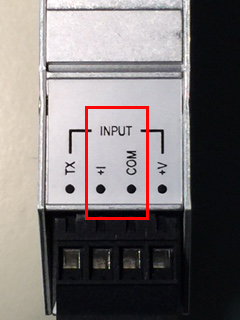
This wiring configuration creates a “failsafe” situation. For example, should the level switch accidentally fail to open, or the 24Vdc become short circuited, then that tank is reported ‘NEAR FULL’ (4mA signal). A detailed wiring schematic can be found in Figure 2.
Figure 2. Tank Wiring and Setup

- The float cage signal is converted using resisters (6000Ω and 1500Ω)and a regulated bulk 24Vdc power supply, connected to the TMZ, which is then connected to the RS-485 port (MODBUS) of the new WNM.
- The TMZ converts the analog signal to a MODBUS output that is connected to the WNM's RS-485 port.
- The WMN, also powered by the existing bulk24Vdc power supply, transmits signals wirelessly from the new tanks across the river to theWNM radio network connected to the DCS’ MODBUS network.
Details on Configuring the TMZ Transmitter to Communicate Data via MODBUS
Use the Model TMZ programming cable and free programming software to configure the Model TMZ for each tank. Assign a MODBUS address to this storage tank TMZ. Configure the baud rate, parity, etc. to match that of all other MODBUS devices.
Configure the Model TMZ ‘Custom Curve’ feature such that current less than 5mA is ‘0.0’ (‘NOT FULL’) and current above 19mA is ‘1.0’ (‘NEAR FULL’).
(Note: This was chosen as the customer preferred the valve state for filling the tank to be 0 for open, and 1 for closed).
For example, a simple four point custom curve like the following will work:
Figure 3. Four Point Custom Curve
| Point | X Data | Y Data |
| 1 | 4 | 0 |
| 2 | 5 | 0 |
| 3 | 19 | 1 |
| 4 | 20 | 1 |
WNM Configuration and MODBUS Network Wiring
Configure the Model WNMs as point-to-point radios and choose all other settings as required. Moore Industries Application support pre-configures the WNMs prior to shipment from the Moore Industries factory, making the WNMs ‘ready-to-use’ upon arrival.
Wire the Model TMZ and WNMs to the twisted pair MODBUS network. See TMZ and WNM instruction manuals for RS-485 wiring diagram.
Have questions, or want help with your application?
To learn more about this application, read the Tank Farm Application and Monitoring Solution page.
If you have questions or need help on your own application, send us a message using E-Help.
If you want product information, visit the catalog.
The Problem:
A Moore Industries customer wanted to monitor levels in new storage tanks that are remotely located on their tank farm and are not connected to their existing MODBUS network. The details of the customer’s existing tank farm, recent additions and monitoring needs include:
Twenty existing tanks are monitored using MODBUS continuous level sensors with data transmitted over a RS-485 twisted pair network.
Five new remote tanks were added and need to be monitored, but were built with a level sensing device that only provided a dry contact output from a float cage to indicate level, no MODBUS output available.
The customer needs to convert the dry-contact output from the new remote tank level devices to a MODBUS signal that indicates two level states: NEAR FULL or NOT FULL and then transmit the data via MODBUS for monitoring at the Distributed Control System (DCS).
The new remote tanks could not be connected to the existing MODBUS network using twisted pair wire because they are located across a river from the existing tanks and the DCS.
The Solution:
Summary
Moore Industries Applications Engineers provided the customer with a cost effective and simple solution for monitoring their new storage tanks that utilized their existing technologies. After reviewing their situation the following issues needed resolving:
- Dry-contact (discrete) output to analog signal conversion
- Analog signal to MODBUS translation
- Getting the signals to the DCS from the tanks across a river
The first step involved using a pair of resistors and a bulk DC power supply to convert the dry-contact relay output from each tank’s float cage to a 4-20mA signal. Next a Moore Industries TMZ PC-Programmable MODBUS Transmitter (Signal Converter) was used to read and convert the 4-20mA signal into MODBUS. And finally the new MODBUS signals had to be connected to the existing MODBUS network across the river. This involved installing a pair of Moore Industries WNMs (Wireless Network Modules) that utilized a point-to-point wireless network link across the river.
Figure 1. below shows the Tank setup with dry-contact outputs in a float cage, resistors, TMZ transmitter, and the WNM wireless module necessary to add the five new tanks to the MODBUS network and DCS across the river.
Figure 1. Tank Wiring and Setup

- The float cage signal is converted using resisters (6000Ω [4mA for current loop one float level] and 1500Ω [an 'additional 16mA' to signal other float level]) and a regulated bulk 24Vdc power supply, connected to the TMZ, which is then connected to the RS-485 port (MODBUS) of the new WNM.
- The TMZ converts the analog signal to a MODBUS output that is connected to the WNM’s RS-485 port.
- The WMN, also powered by the existing bulk 24Vdc power supply, transmits signals wirelessly from the new tanks across the river to the WNM radio network connected to the DCS’ MODBUS network.
Installation Specifics
Dry Contact Output and MODBUS Conversion
To solve the problem of getting level data from dry contacts into the existing MODBUS network, the Moore Industries application engineer suggested using a bulk 24dv power supply, a set of resistors and a TMZ MODBUS transmitter to be installed on each new storage tank. The TMZ (Model TMZ/HLPRG/MB/24DC [DIN]) is a very cost effective and flexible instrument. It accepts a direct signal input from a wide array of analog devices and converts the input to the standard MODBUS RTU (RS-485) communication protocol for direct interface with MODBUS-based monitoring and control systems.
The TMZ is powered in this application using a 24Vdc power supply at each new tank location. This same bulk power supply was then used in conjunction with resistors to convert the dry contacts to an analog signal (DC milliamps) that the TMZ could read. The engineer connected the dry contacts’ two discrete terminals to the TMZ using a pair of resistors, 6000Ω and 1500Ω, to create a current loop signal representing the two different tank levels.
The TMZ translates the analog signal to a digital MODBUS communications signal. Each TMZ was then connected to a RS-485 twisted pair network that was routed from tank to tank. Each storage tank TMZ has a unique MODBUS address assigned by the installer, which allows the DCS to distinguish individual tank level data.
Wireless Transmission
The Moore Industries WNM Wireless Network Module used in this application is a bi-directional, point-to-point or point-to-multipoint, 900 Mhz frequency hopping spread spectrum radio modem that includes a RS-485 port. In order to connect the two MODBUS networks together across the river, a set of WNMs was used in point-to-point configuration. Each WNM can also be simultaneously configured as a tank site source and a wireless repeater, allowing for virtually unlimited transmission range. Since the customer already had a MODBUS RTU data communication network, the WNM’s RS-485 port made it an ideal choice for this application.
At the new storage tank, the engineer installed a Model WNM radio and connected it to the newly installed MODBUS RTU network. The MODBUS RTU communications signal received by the WMN over the twisted pair wires is transmitted by an antenna to the peer WNM radio that is now connected to the original MODBUS network and DCS across the river. This essentially created an extension to the existing MODBUS RTU network through the radios. This now allows bi-directional communication between the DCS and any tanks located across the river.
Get more detail on how the dry contacts were converted to an analog signal, and how the TMZ is configured to convert 4-20mA signals to MODBUS, see supplementary information.
If you have questions or need help on your own application, send us a message using E-Help.
If you would like product information, visit the catalog.
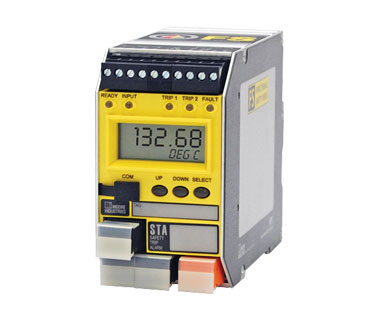
Moore Industries-Pacific recently sold 221 STA Safety Trip Alarms to be used in a Functional Safety coal gas extraction application in Australia. A Coal Seam Gas exploration company with hundreds of sites in Queensland has production wells with up to 10 inputs controlled locally by Remote Terminal Units (RTUs). The STA will be implemented as part of their independent Protection System with a level alarm on each wellhead separator. Larger volume production wells may need up to four separators per RTU panel.
The Coal Seam Gas exploration company has been using our SPA2 alarms in this application since 2005. Their reliability and simplicity of programming have made Moore Industries the company’s first choice alarm provider. They chose the STA over the SPA2 for this project due to the fact that the STA is a SIL 3-capable device and provided additional diagnostic coverage to continually check the alarm trip's operational status and health.
Do you want more information? Download the data sheet. Or visit the catalog.
Need to get price or availability or have a technical question? Send us a message using E-Help.
Municipalities often have several wet well locations around a city that pump waste from low lying areas up to main sewage veins that feed waste treatment plants. Level instruments monitor the wet well level and controllers then engage the grinder pumps. Since wet wells contain waste, volatile gasses such as methane require that these level instruments be rated for use in Class I, Div 1 environments.
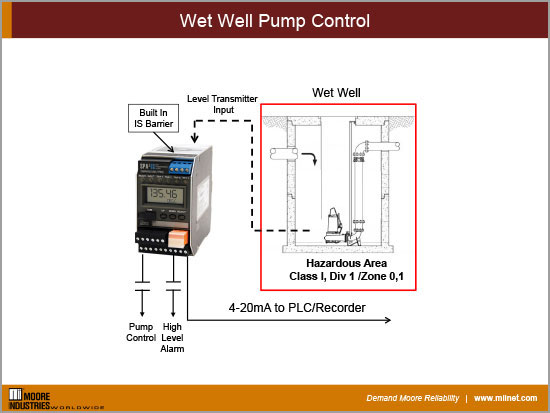
When IS (Intrinsic Safety) is chosen as the method of protection, a separate IS barrier is required for each level transmitter that is wired to the pump controller. The SPA2IS Site Programmable Alarm with Associated IS Input capability includes a built-in IS barrier for the level instrument located in the wet well. This means that the separate IS barrier does not have to be purchased, installed and maintained. The SPA2IS has four alarms, each configurable with 0-100% deadband, which makes it an ideal fit for a wet well level controller.
Key Attributes:
- Includes built-in IS barrier for hazardous sensors and transmitter connection
- Easy to program with local push buttons or free PC software
- Up to four alarms with an auxiliary analog output
Water and waste facilities, whether local or remote, have many locations where sump monitoring and control are required. When it isn’t economical to use a PLC or due to its remote distance away from other control loops, an advanced alarm trip may do the job.
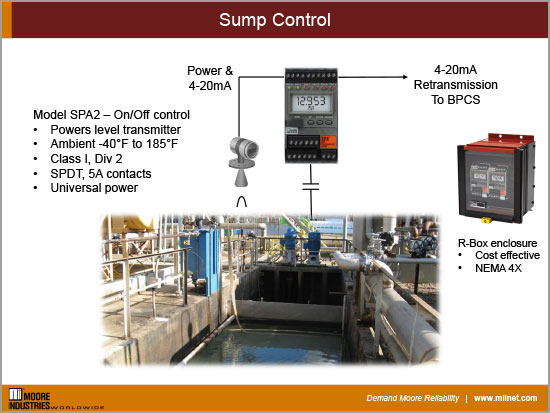
The SPA2 Site Programmable Alarm Trip is a very versatile and smart device that allows you to control as many as four pumps or motors simultaneously. The SPA2 has up to four programmable SPDT relays all rated at 5A, 250VAC that can be programmed has high or low with adjustable time delays and deadbands that make it an ideal candidate for on/off level control. Additionally, the unit has a universal power supply, powers the level transmitter that it monitors and features an auxiliary analog output in case there is a need to retransmit the level reading. Rated Class I Div 2/Zone 2 the unit includes an integrated display and is programmable via the local pushbuttons or with a free intelligent PC program. Designed for remote and outdoor locations the SPA2 operates in ambient conditions of -40 to 85C (-45 to 85C).
Key Attributes:
- Four SPDT Relays rated at 5A, 250VAC
- Class I Div 2/Zone 2 approval
- Programmable for on/off control with adjustable deadband and auxiliary output
Fabrication rooms in semiconductor facilities require close monitoring of humidity. Often getting the humidity reading in the middle of the room is ideal, close to the wafer machine.
![]()
When this is required, consider the flexible humidity probe for the HTZ Humidity and Temperature Transmitter. The flexible sensor is an armored cable up to 10 feet long that can be mounted through the ceiling through a 1” NPT coupling and adjusted downward to the desired measuring point. The HART programmable HTZ has a remote display and has two analog outputs that can be programmed to output humidity, temperature or dew point.
Key Attributes:
- Versatile flexible humidity sensor design
- +/- .75% humidity measurement
- HART programmable with two outputs and local display
Semiconductor facilities require close monitoring of humidity in their HVAC and fab rooms. The HTZ Humidity and Temperature transmitter has a versatile duct mounted sensor assembly that is ideal for monitoring humidity and temperature in a duct.
![]()
Additionally, the sensor can be wall mounted for clean room humidity and temperature monitoring. The HART programmable HTZ has a remote display and has two analog outputs that can be programmed to output humidity, temperature or dew point.
Key Attributes:
- Versatile duct mount/wall mount designed humidity sensor
- +/- .75% humidity measurement
- HART programmable with two outputs and local display
The cooking process that takes place in digesters at paper mills produces off gasses like hydrogen sulfide that, should they be accidentally released, could cause immediate suffocation of plant personnel. For this reason, gas detectors are placed in low lying areas where gasses that are heavier than air can immediately be detected.
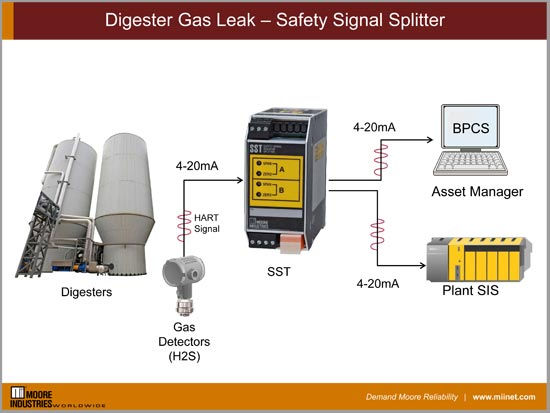
Due to the dangerous nature of this potential leak Safety Instrumented Systems (SIS) are often implemented. Often these gas detectors are also monitored by the Basic Process Control System (BPCS) too. When this is a requirement, look to the Functional Safety Series SST Safety Splitter. The four-wire SST is an exida approved SIL 2 capable signal splitter, with Class I Div 2/Zone 2 approval, that sends your critical process signal to two remote locations. The SST also passes valuable HART diagnostic and process variable data through the SST in case asset managers need to view calibration or other essential diagnostic data from the field transmitter.
Key Attributes:
- exida approved and Class I Div 2/Zone 2, SIL 2 capable for SIS loops
- Full four-way isolation up to 500Vrms between power and all input/outputs
- Passes critical HART data from field transmitter
The wet end of large paper machines requires precise control of the paper stock as it is laid on the wire. Normally several small valves are evenly spaced across the wire to ensure a uniform distribution of paper stock.
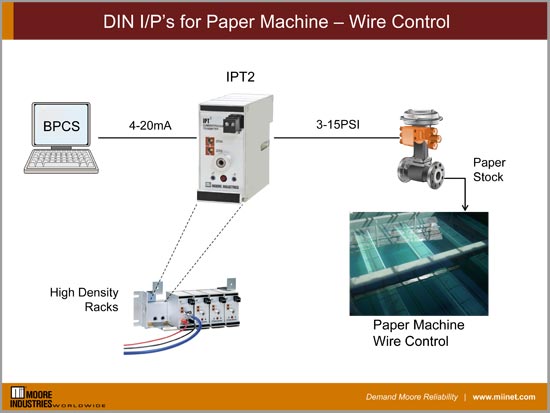
Since these wire control valves are too small to accommodate a field mounted I/P or positioner, the highly accurate and repeatable two-wire loop powered IPT2 DIN mount Current-to-Pressure transmitter is a perfect solution. The IPT2 can be rack mounted for high-density installations in 5, 10 or 15 position racks that simplify air supply, filtering and regulation due to its backplane header design. The IPT2 includes a pneumatic closed loop feedback circuit for optimum control, has front mounted test leads to monitor the input and offers an optional front mounted pneumatic test jack.
Key Attributes:
- Highly accurate and repeatable
- Excellent resistance to vibration and closed loop feedback circuit
- High-density installation option
Drum level control for a boiler at Power plants is very critical to daily operations. If there was a fault with the primary controller handling the PID level control, it is quite likely that power product would stop or be severely hampered.
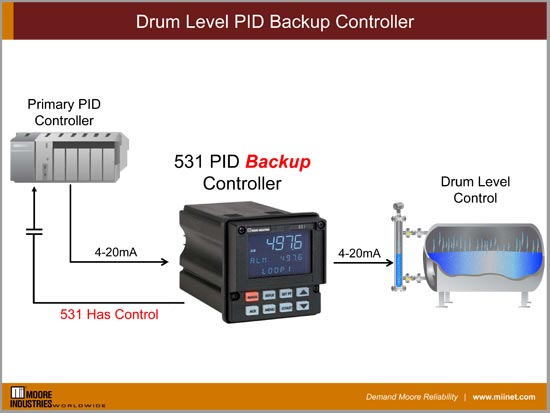
Consider the ¼ DIN 531 Hot PID Backup Station for these and other mission-critical applications. The 531 is specially designed for applications where it is the secondary control master on critical loops. In normal operations the 531 simply monitors the 4-20mA signal passing through it to the final control element. If there is a catastrophic failure of the primary PID controller, the 531 picks up where the primary left off and takes over PID control. A notification is sent to the primary controller or other watchdog systems to let facility operations know that there has been a problem and the secondary PID controller has taken over. The 532 features a large vacuum fluorescent display with a large five digit upper display and two nine-character lines of alphanumerics.
Key Attributes:
- Easy to configure
- HOT PID Backup station
- Large display with local indication of PV and CV-Nema 4X case with UL Approval
Pumps are extremely critical devices at Power facilities. If pumps fail, turbines and other key parts of the power generation plant will be shut down. One common point of failure in pumps is bearing failure. Most large pumps have bearings that wear out over time and temperature is normally a good way to monitor the pump bearings looking for wear or simply to perform routine maintenance. While control systems can monitor pumps many times these pumps are remote to the control room.
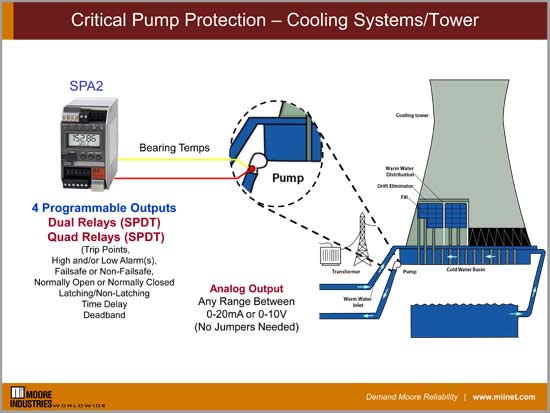
Using a TC or RTD and a SPA2 Site Programmable Alarm Trip is an effective local layer of protection strategy. The Class I Div 2/Zone 2 SPA2 includes up to four programmable SPTD relays rated at 5AAC that can be programmed to warn of pending pump failure. Powered with a universal power supply the SPA2 can be programmed via the local pushbuttons or with free PC programming software and a USB cable.
Key Attributes:
- Universal temperature sensor input
- Four programmable relays rated at 5AAC, 250VAC
- Easy programming and universal power supply
Petrochem facilities have hundreds of motors installed throughout various processing units. Monitoring of these motors for more precise control or protection is paramount.
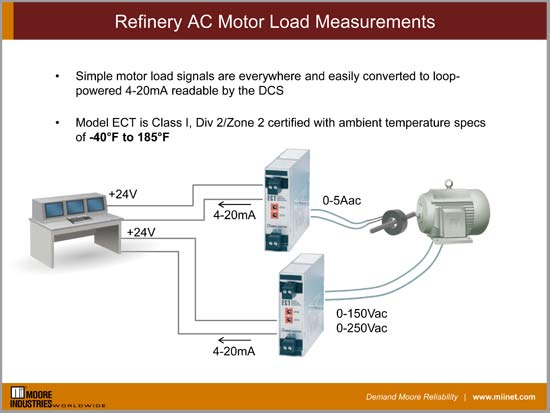
Click here to download the PDF file
The model ECT is a Class I Div 2/Zone 2 DIN rail, loop-powered (two wire) signal converter with an operating range of -40 to 85C (-40 to 185F) that accepts AC current inputs of up to 0-5A AC and outputs a linear and noise free 4-20mA signal readable by the BPCS or PLC. As an added safety feature, the ECT offers an optional externally mounted mini-CT (Current Transformer) that steps 0-5A AC down to 0-5mA AC so technicians don’t have to worry about handling high current signals. ECT also accepts high-level AC voltage inputs too.
Key Attributes:
- Two wire loop-powered AC signal converter
- Class I Div 2/Zone 2 approvals
- High ambient operating temperature range of -40 to 85C (-40 to 185F)
Refineries and petrochemical plants use steam to heat vessels and different parts of their process units and if steam pressure rises too high it could create a dangerous situation. Monitoring and alarming on steam pressure adds a layer of protection for personnel and process. But many times these points are remotely located where it isn’t practical to run multiple twisted pairs to and from the control room or closest PLC.
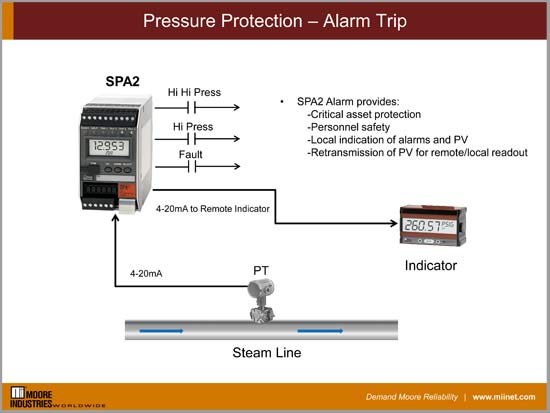
Click here to download the PDF file
When remote alarms or layers of protection are required, look to the SPA2 Site Programmable Alarm Trip. The SPA2 is push button or PC programmable alarm trip, or trip amp, that offers high, low, rate of change, fault, out of range, input failure alarm types. Fitted with a universal power supply, it has up to four programmable SPDT alarms with an optional auxiliary analog output and a loop power supply for powering two-wire transmitters. The SPA2 is approved for installation in Class I Div 2/Zone 2 locations.
Key attributes:
- Versatile and easy programming with push buttons or PC software
- Up to four SPDT relays rated at 5A 250VAC/24VDC
- Suited for installation in Class I Div 2/Zone 2 locations
Upstream/Midstream oil and gas wellhead sites are in remote areas that often rely on solar power to run instrumentation and monitoring systems. During winter months maintaining voltage levels from their solar sources is challenging and finding instruments that have minimum power requirements is critical.
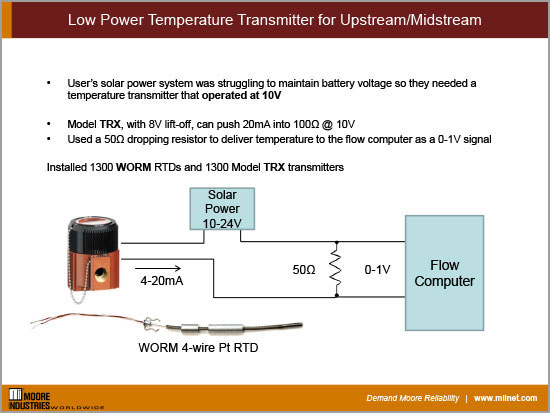
Click here to download the PDF file
The model TRX Temperature Transmitter only requires eight volts to operate and can push 20mA through 100 ohms at 10 volts. By utilizing a 50 ohm dropping resistor a 0-1 volt signal representing temperature can be efficiently transmitted to the onsite flow computer.
Key attributes:
- Low eight volt liftoff for TRX Temperature Transmitter
- TRX Universal Input for any TC or RTD
- Full hazardous area approvals
Many mining locations require layers of process protection to prevent unnecessary exposure to dangerous situations that may harm personnel or the environment, like gas exposure. Most mining operations have implemented Safety Instrumented Systems (SIS) in compliance with IEC 61511 to mitigate the exposure to such dangerous events.
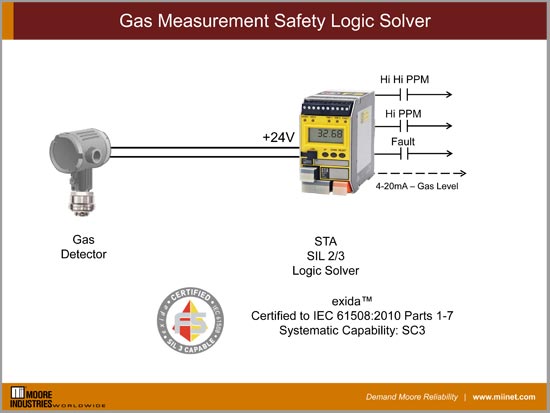
When required to add layers of protection at the mine site, consider the STA Functional Safety Trip Alarm as your Safety Instrumented System logic solver when a dangerous condition occurs. The STA is simple to program and has an auxiliary analog output for retransmission to the local RTU. The STA is SIL 2/3 capable, approved by exida and rated for installation in Class I Div 2/Zone 2.
Key attributes:
- exida approved, SIL 2/3 capable
- Easy programming
- Class I Div 2/Zone 2 approval and local display
Milk producers are required to ensure proper pasteurization takes place before their products can be delivered for consumption. This requires tight temperature control and monitoring.
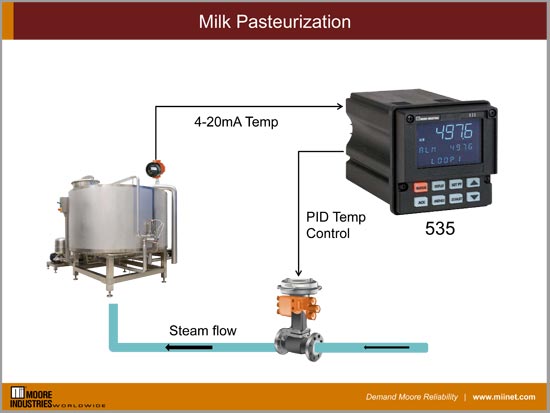
When pasteurization or sterilization is required to look to the NEMA 4x Model 535 ¼ DIN PID Controller. This versatile yet easy to program controller can perform P, PI or PID control with built-in auto-tuning and other advanced programming features. The controller features a large vacuum fluorescent display with a large five digit upper display and two nine character lines of alphanumerics. In addition to the CV (Control Variable) output, up to three additional relay or analog outputs can be configured.
Key Attributes:
- Easy to setup and configuration menu
- Easy to use PID auto-tuning
- Large display and additional outputs
Food and beverage and pharmaceutical companies have several processes that require validation due to FDA and other international safety laws. When some measurements need to be shared between the primary process control system that is validated and an auxiliary control system, like building automation, it requires full isolation.
When this need arises using an ECT DIN Signal Splitter Isolator that provides the sufficient area isolation to meet validation needs. The UL approved ECT signal splitter now allows the non-validated system to be brought offline and calibrated separately without affecting the calibration or operation of the primary validated loop.
Key Attributes:
- Full four way isolation up to 500Vrms between power and all input/outputs
- RFI/EMI resistant and hardened aluminum case
- Zero and span potentiometers for onsite calibration
You can’t always plan for every loop condition in a chemical plant. Sometimes input cards are active and sometimes passive. Field transmitters are sometimes line powered (four-wire) which usually have active outputs, and sometimes they are passive (two-wire). Has the Basic Process Control System been updated with HART smart input cards? Has there been a new asset manager installed that needs the HART signal?
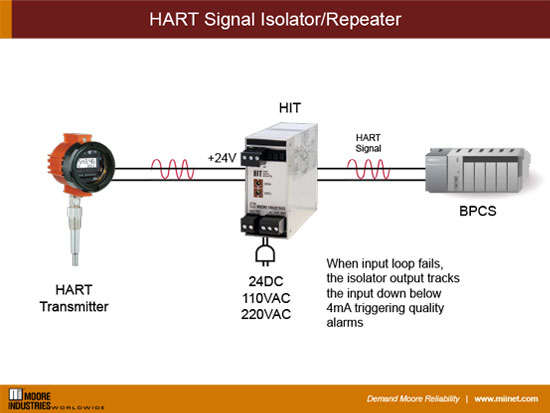
When those unplanned situations exist, you can turn to the HIT HART Pass-through Signal Isolator. The HIT isolator provides superior noise rejection and full three-way isolation with HART pass-through capability. Another very important feature of the HIT is that the output will track the input all the way to 0mA when it fails; as opposed to most other isolators that simply go to 4mA – which is always difficult to ascertain between a failure of the input or just 0% scale. Lastly, the HIT can be used on non-HART or HART based loops when asset managers need that valuable diagnostic and calibration data.
Key Attributes:
- Class I Div 2/Zone 2 approval
- HART pass-through capability
- Output tracks to 0mA on failed input
When Safety Instrumented Systems (SIS) are applied within a chemical facility you can’t always plan for every loop condition. Sometimes input cards are active and sometimes passive. Field transmitters are sometimes line powered (four-wire) which usually have active outputs, and sometimes they are passive (two-wire). Moreover, is the field transmitter HART capable or not?
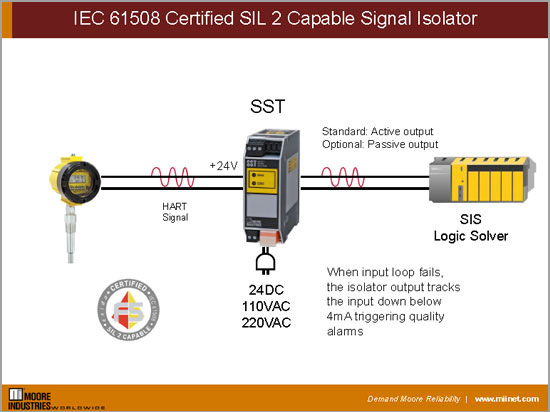
When those unplanned situations exist, you can turn to the Functional Safety Series SST Signal Isolator. The SST is an exida approved four-wire SIL 2 capable isolator that provides superior noise rejection and full three-way isolation with HART pass-through capability. Additionally, the input to the SST can be wired in the field as an active input (applies power to the two-wire field transmitter) or passive input. The output of the SST can be ordered as active or passive. Another very important feature of the SST that is very critical for an SIS, is that the output of the SST will track the input all the way to 0mA when it fails; as opposed to most other isolators that simply go to 4mA – which is always difficult to ascertain between a failure of the input or just 0% scale.
Key Attributes:
- exida certified to SIL 2
- HART pass-through capability
- Output tracks to 0mA on failed input
An overpressure situation in pipes is dangerous and can lead to significant damages to property, pipe ruptures and even injuries and death. Having a system in place to prevent an overpressure situation is critical and one way to accomplish this is with a High Integrity Pressure Protection System (HIPPS).
 A HIPPS provides a barrier between high pressure and low-pressure parts of an installation to prevent the release of fluid or gas into or otherwise contaminate the environment. An example of a HIPPS is an offshore well platform where the subsea oil or gas lines can occasionally present a harmful pressure surge in the pipeline. The HIPPS is designed to shut off the source before the design pressure of the downstream process is exceeded, avoiding a rupture of a line or vessel.
A HIPPS provides a barrier between high pressure and low-pressure parts of an installation to prevent the release of fluid or gas into or otherwise contaminate the environment. An example of a HIPPS is an offshore well platform where the subsea oil or gas lines can occasionally present a harmful pressure surge in the pipeline. The HIPPS is designed to shut off the source before the design pressure of the downstream process is exceeded, avoiding a rupture of a line or vessel.
A HIPPS consists of three main components:
•Pressure transmitters
•Logic solvers
•Fast-acting shutoff valves
Many people assume that the logic solver has to be a safety PLC. But in many cases, a discrete logic device for each loop, which avoids the complications and expense of a programmable solution, is a sensible option. The “Logic Solvers for Overpressure Protection” white paper shows how discrete logic devices such as the STA Safety Trip Alarm are suitable for use while providing a flexible, low-cost and user-friendly solution.
While the safety PLC approach offers advantages for installations where there are a high number of field I/O safety loops, many plants have few such loops. For these plants, discrete logic solutions offer several advantages including creating a simple architecture, reducing cabling costs and avoiding the development cost of application programming.
The STA is easy to install with its wide range of power supply options and its small package that helps to keep it separate from non-safety instrumentation. In the event of maintenance due to transients or failure, it can be readily swapped out at a low unit and operational cost without interfering with the other processes in the plant. Local indication gives reassurance that the status of safety loops is reported directly.
The “Logic Solvers for Overpressure Protection” white paper shows safety engineers the steps needed to determine the right logic solver for their SIS. It shows the methodology and calculations for determining the applicability of logic solvers in SIL 1 and SIL 2 environments. It includes examples of system topologies and their associated Safety Integrity Level (SIL) calculations.
The STA Safety Trip Alarm is part of Moore Industries’ FS Functional Safety Series of instruments. Each of these instruments is designed and built in compliance with IEC 61508, the leading worldwide functional safety standard, and certified by exida for use in a Safety Instrumented System. In addition to our FS Series of products FMEDA (Failure Modes Effects and Diagnostic Analysis) reports available on many of our products that are used in safety applications.
Find out more information about these products at the FS Functional Safety Series section of our website. You can also download the related “Logic Solvers for Tank Overfill Protection” white paper.
Q: We have an existing Rosemount 1151DP tied to a Provox DCS. We also have a Moore Industries DDA 4-Wire Current and Voltage Alarm in the system to provide a Flow Switch Low and Flow Switch High interlock to our gas supply valves. Will newer products from Moore Industries provide more – or better – protection than the DDA?

A: The STA Safety Trip Alarm and SPA2 Site Programmable Alarm have alarm functions and can be used instead of the DDA. Both products have FMEDA reports which define the Probability of Failure on Demand and can provide a better degree of protection than the DDA. Additionally, the HIM HART Interface Module has alarming functionality that could also be used with the 1151DP transmitter.
The STA monitors the analog signal and is specifically designed for IEC 61508 applications. It is approved by exida for use in Safety Instrumented Systems (SIS) up to SIL 2 and in redundant architectures (1oo2, 2oo3, etc.) up to SIL 3.
Like the STA, the SPA2 can also monitor the analog signal and provides up to four alarms, a display, and an optional 4-20mA retransmission. The SPA2 is our most popular alarm choice for loops that are not specifically designed in accordance with IEC 61508/61511The HIM monitors the digital component of a HART signal and can be specified with up to two optional relay outputs, which can be configured for signal level alarms or for a number of HART status bits. It can be used to provide diagnostic coverage for a HART transmitter since it monitors the transmitter’s status bits.
Do you want more information? Look up a data sheet to download. Or visit the catalog.
Need to get price or availability or have a technical question?
Send us a message using E-Help.
Moore Industries is continually updating our website with new datasheets, user’s manuals, CAD drawings, configuration software and other materials.

Remember that our website is the definitive place to find the most up-to-date product information, so please check here when you need something.
Among the new files currently available on the website is an update to the CPMS Cathodic Protection Monitoring System datasheet to reflect the new GPS Time option. This is an optional method for keeping accurate time when an SNTP (Simple Network Time Protocol) network is not available.
Here are some of the files that have recently been updated on our website:
Datasheets:
CAD Drawings:
Other:
Do you want more information? Download the data sheet. Or visit the catalog.
Need to get price or availability or have a technical question?
Send us a message using E-Help.
Q: I need a 4-wire isolator and want to see if your MIT Multi-Channel Signal Isolator will work in my application. I have several 4-wire transmitters where I need to split and isolate the output signal to receivers that are passive (not powered). Will the MIT work provided that I supply 24Vdc power to the unit?
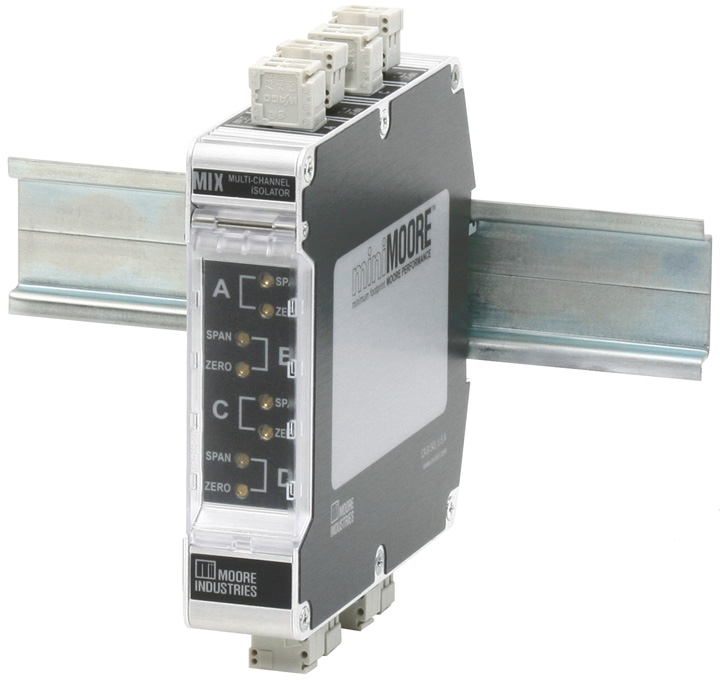
A: The MIT appears to be a perfect fit for your application. MIT’s input is passive, so it is compatible with the active output of a 4-wire transmitter. Because its outputs are active, they are compatible with the passive inputs of the receiver devices. In addition, it uses a universal power input, so it will accept 24Vdc power.
Do you want more information? Download the data sheet. Or visit the catalog.
Need to get price or availability or have a technical question?
Send us a message using E-Help.
State regulations required a major pulp and paper company to monitor and record daily effluent water rates. This requirement was being fulfilled by sending an employee from their main control site to a remotely located pond three times a day to manually record water levels. This process was inefficient, time-consuming and didn’t provide them with real-time data.
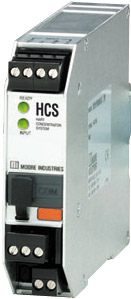 By installing a system utilizing technology from Moore Industries, the pulp and paper company implemented a system that is scalable for future installations while reducing employee workload and maintaining state regulatory compliance. This process is detailed in a white paper available for download on our website. It highlights how the use of the HCS HART Concentrator System and the NCS NET Concentrator System were critical in helping the company efficiently comply with government regulations.
By installing a system utilizing technology from Moore Industries, the pulp and paper company implemented a system that is scalable for future installations while reducing employee workload and maintaining state regulatory compliance. This process is detailed in a white paper available for download on our website. It highlights how the use of the HCS HART Concentrator System and the NCS NET Concentrator System were critical in helping the company efficiently comply with government regulations.
HART flow level measurements at the pond site were converted to MODBUS RTU by a HCS and sent from a WNM Wireless Network Module at the pond to a receiver radio at the boiler control room. The information was relayed from the wireless radio to an HMI display and DCS/Historian by the NCS. This system enables the company to efficiently get accurate and required readings on the levels in their effluent water system.

Do you want more information? Download the data sheet. Or visit the catalog.
Need to get price or availability or have a technical question?
Send us a message using E-Help.

































